






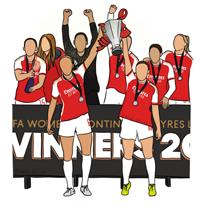



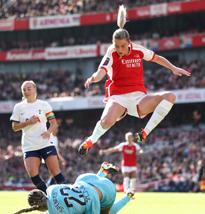




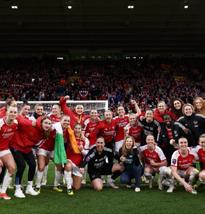
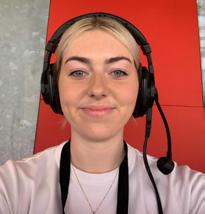


Hello, and a hearty welcome to the first ever Gooner Fanzine digital issue solely dedicated to Arsenal Women and the women’s game.
I have been hooked on Arsenal Women nee Ladies, since part of my brief when I was Arsenal reporter at the Islington Gazette newspaper was to cover the side at Meadow Park.
Arsenal Women are just as much a part of The Arsenal as the men. So, given the incredible growth of Arsenal Women – and the game in general since I sat at Wembley with my eldest daughter Charlotte watching the Lionesses win the Euroswe thought it was about time we produced and published a special digital issue packed with some of the most exciting writing talent around.
Thank you
First and foremost I have to say a massive thank you to everyone who has supported this pilot project – if all goes well we plan to run four digital issues next season.
Huge thanks to all who have backed us: AST, AISA, and Raymond James Hitchin.
Thanks also to the production genius that is Sergio BragaMullin, and to Freddie Cardy for his boundless energy in helping identify and select such a raft of exciting writers.
And of course my wonderful partner Faye who has been such an incredible support, and without whose understanding and backing this issue simply wouldn’t have been possible.
(You may have seen Faye and my youngest daughter Josie flogging the print issue of the Gooner Fanzine at women’s games at the Emirates recently. A team I’m so proud of.)
It’s certainly been a race against time to get this Labour of Love completed for the Arsenal vs Leicester game. We have had plenty of late nights burning the midnight oil in a bid to get this issue ready on time – and it’s been a close-run thing to meet the ambitious deadlines we set ourselves, on top of our day jobs.
Not least because I am currently writing these notes on a German train somewhere between Dortmund and Munich as I head down to cover Bayern Munich vs Arsenal – so kudos to Serge and Freddie for their hard work in helping to coordinate everything, despite me not being in the country.
If we can all pull this issue off, then imagine what we can do when we’re all in the same room – or even the same country…
Apart from regularly lifting silverware through excellent football (see our front cover) when I first started watching/

covering the women’s team I was blown away by the vibes you got from the entire team and fellow fans.
Addicted, I also started taking my two young daughters, and we all went as Gooners – not least because the inclusivity and the humble nature of the team meant they were far more accessible to supporters than the men.
My youngest still has her signed shirts packed with autographs from the entire team, who without fail signed every single autograph while stopping for a chat with everyone after games at Meadow Park – testament to the link the team has with fans.
In fact, one of my proudest moments as a journalist was covering the first Arsenal team to win at the new White Hart Lane. Back when Joe Montemurro’s mighty reds absolutely bossed and outclassed sorry Spurs in front of a then record crowd in N17.
In the press conference deep afterwards a journo colleague asked Joe what it meant for Arsenal to beat Spurs.
To my surprise the much-loved laconic Aussie (long before Ange Postecoglu tried to trademark that niche) replied with a glint in his eye: “Maaaate, why don’t you ask your maaate,” meaning me. Let me tell you, I’ve never felt prouder.
The fact is I absolutely love watching, supporting, and covering Arsenal Women - and I will never apologise for trying to get others to get on board.
So, the next time you get a chance, why not attend an Arsenal Women’s match. Or support them on the telly. I promise you, you won’t be disappointed.
In the meantime, on behalf of everyone, I really hope you enjoy this issue.
Come on you Gunners. All the best Layth






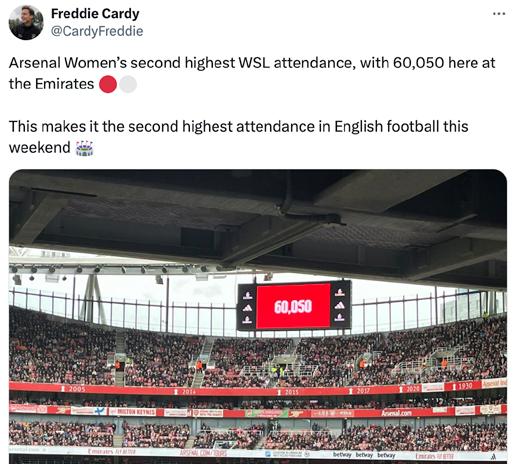

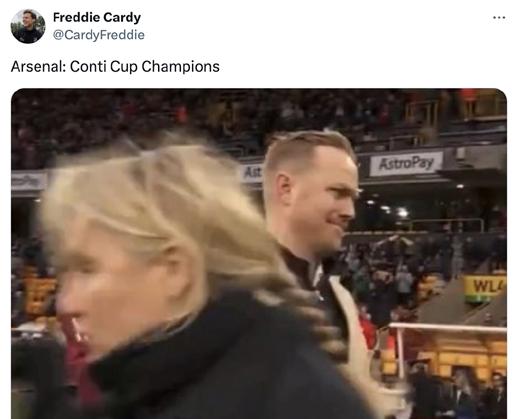

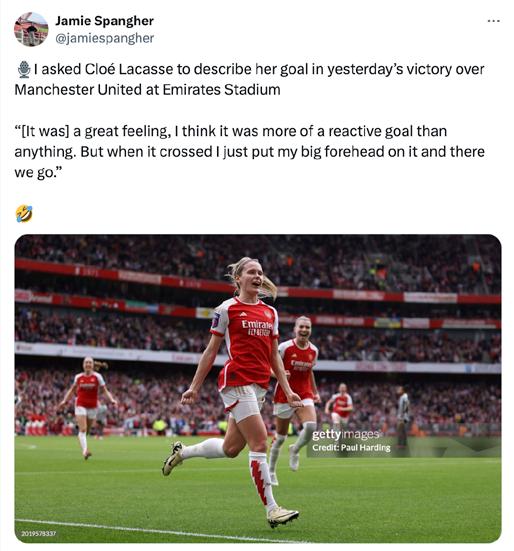









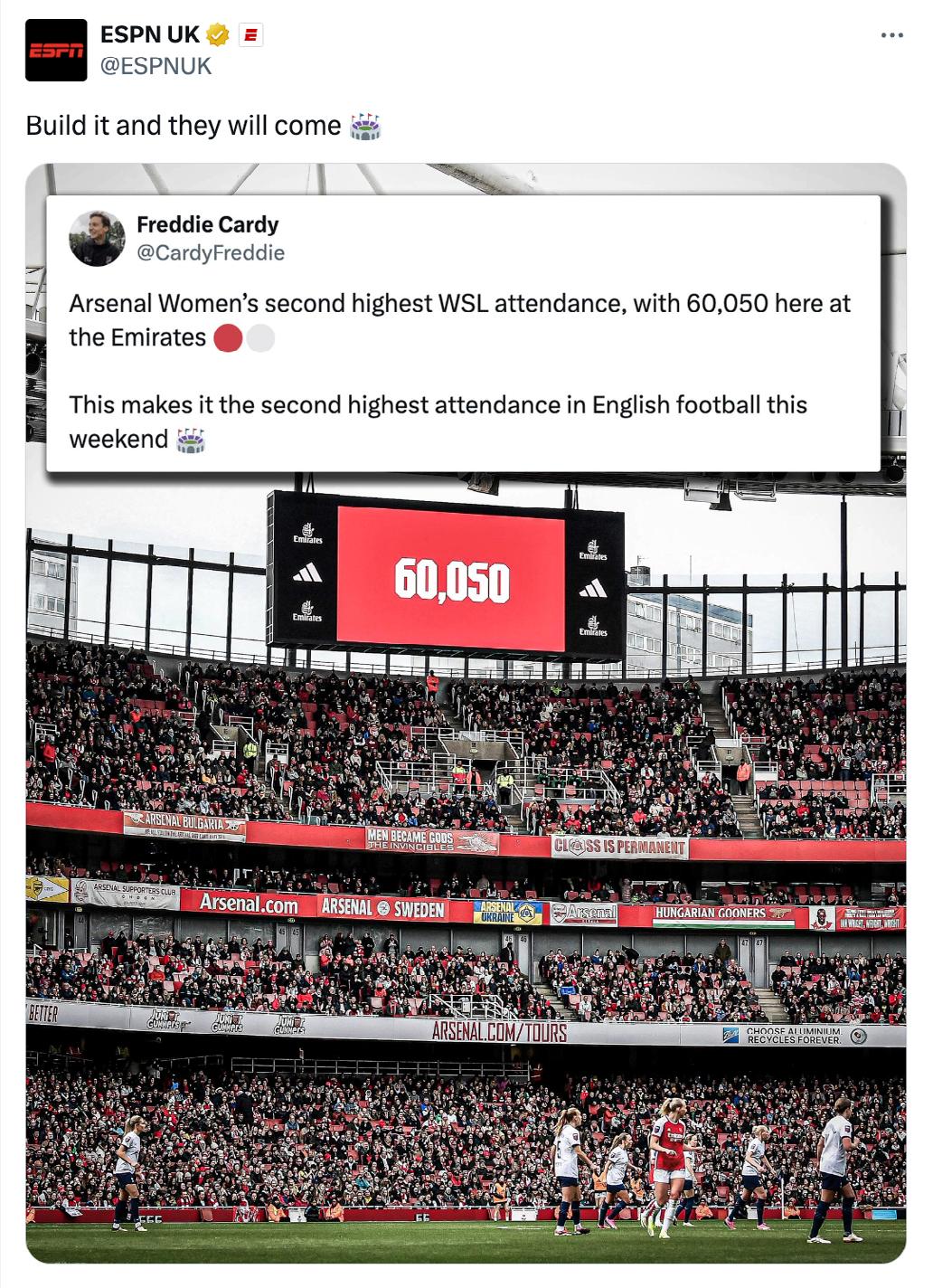



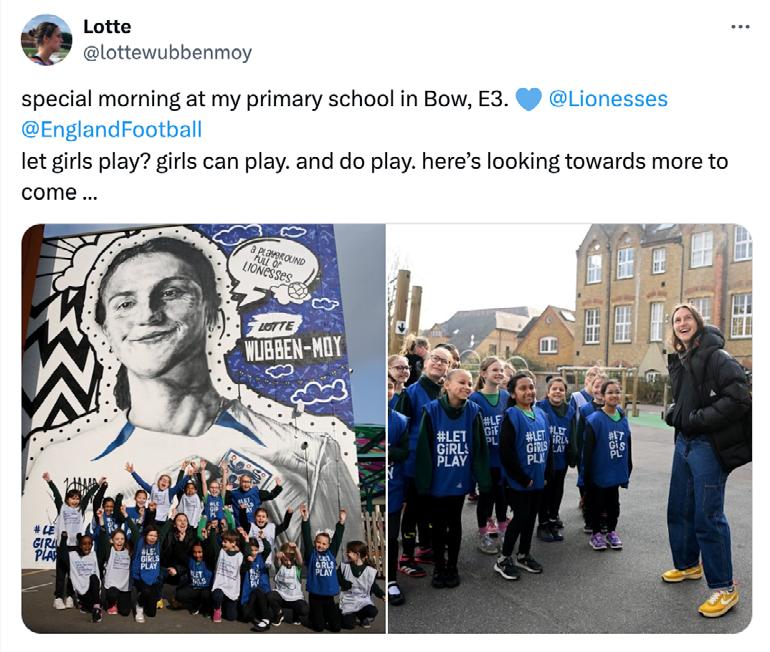

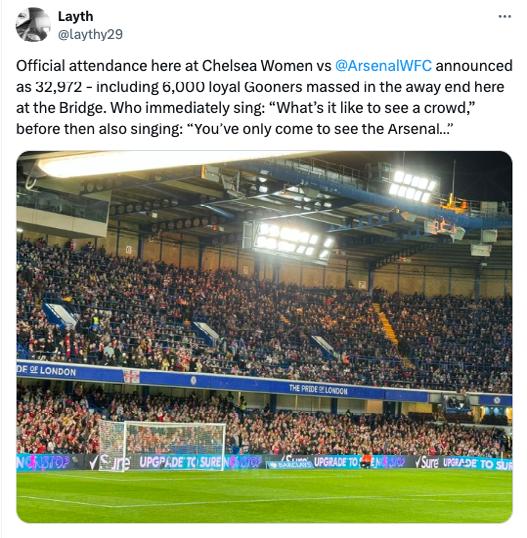





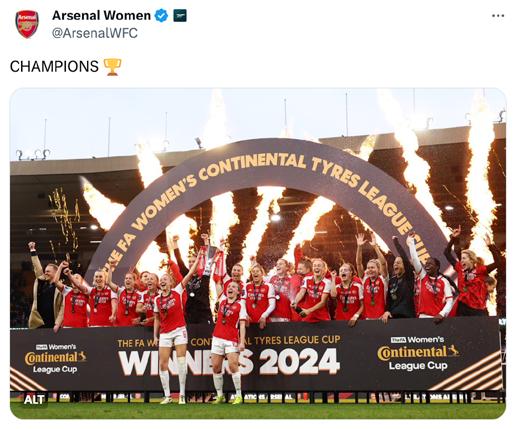




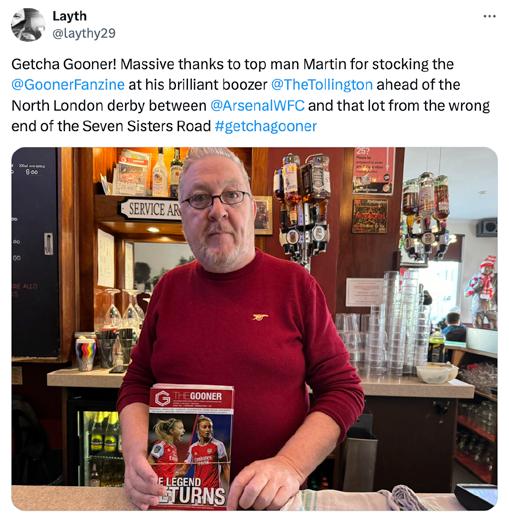

Freddie Cardy’s experiences covering the Arsenal Women during 2024 so far.
The Gooner’s Arsenal Women Reporter Freddie Cardy takes you behind-the-scenes from Emirates sell-outs to sock-gate at Stamford Bridge, with insight into covering AWFC so far this year.

Sunday January 14:
Arsenal v Watford (FA Cup)
I was delighted to see Arsenal drawn against Watford for a few reasons, but mainly because I had a close relationship with the Golden Girls’ head coach Damon Lathrope, who had played a pivotal role in the academy of my local non-league side.
Damon was very generous with his time before and after the game, and you can read my exclusive interview with him about Arsenal’s academy players on loan at Watford on the Gooner Fanzine website.
On the pitch, Jonas Eidevall had somewhat reluctantly allowed academy trio Michelle Agyemang, Laila Harbert and Katie Reid to play against their parent club, and Agyemang found the net for Watford in a 5-1 defeat.
All three of the loanees showed the Meadow Park faithful what they could do, whilst five different players were on the scoresheet for Arsenal. Emily Fox also made her debutmore on her in a moment.
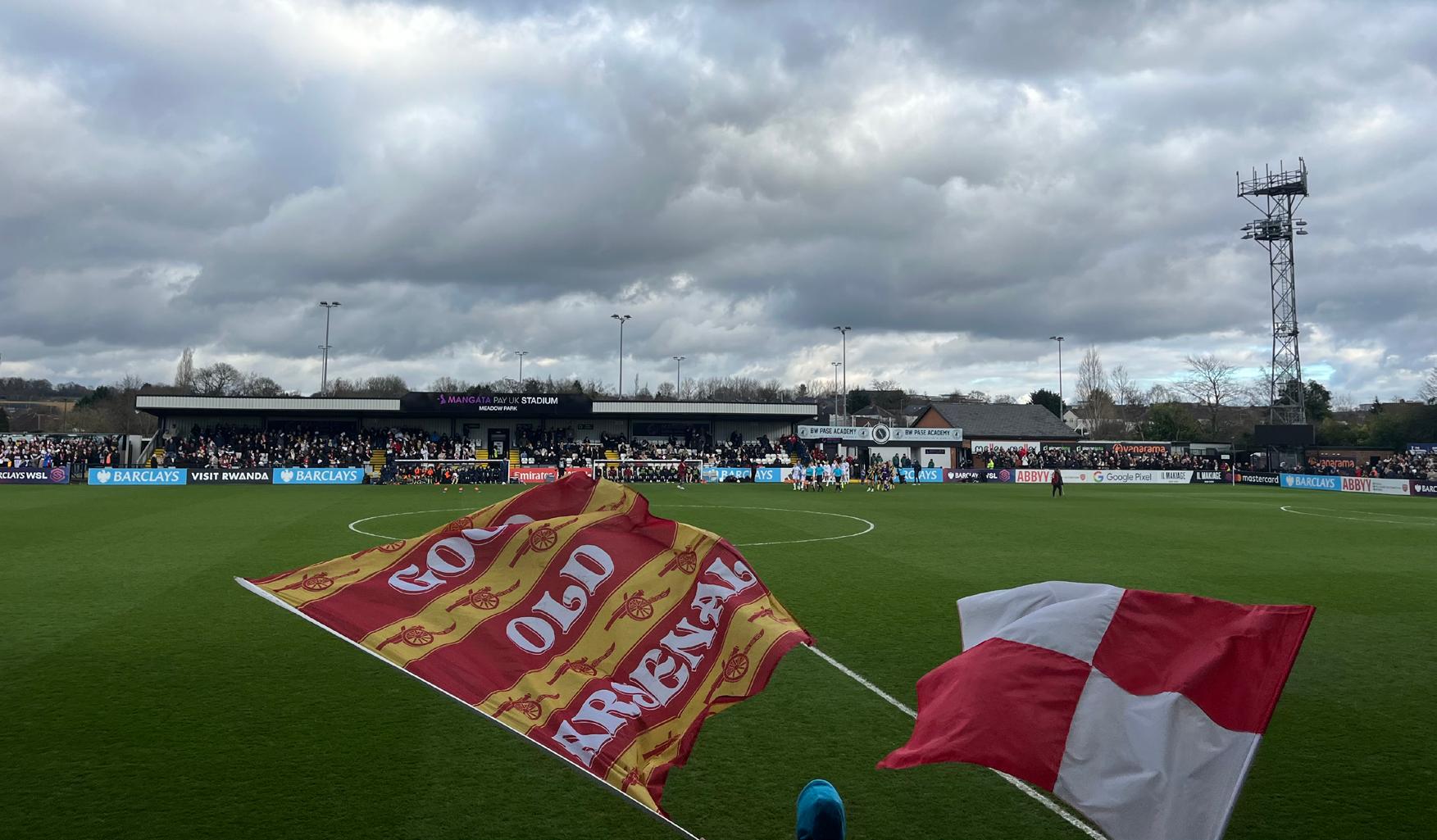


Sunday January 28: Liverpool v Arsenal (WSL)
A long trip up to Birkenhead from Derby was made longer when I realised that Tranmere’s Prenton Park ground, home of Liverpool Women, was seemingly on top of the biggest hill in Merseyside. At least the home fans were friendly.
After a frustrating first-half against a Liverpool side who had beaten Arsenal on the opening day, Vivianne Miedema produced a moment of magic to both break the deadlock on the pitch, and register her first goal after returning from an Anterior Cruciate Ligament injury.
Alessia Russo netted a second, with Emily Fox playing key roles in both goals. The January signing was a revelation at rightback and wasted no time in adapting to English football after switching from the North Carolina Courage to Arsenal.
An important win, and Avanti West Coast even managed to get me home on time. What is it they say about a broken clock?
Sunday February 4: West Ham v Arsenal (WSL)
Where do I start? West Ham’s back five was tighter than the Dagenham & Redbridge press box, and Arsenal just could not find a way through.
They should have had the chance too, but two fairly blatant penalties were denied, and some good chances were put wide.
Oh, and West Ham’s equalising goal came from a spot-kick that should not have been given, too.
But the struggling home side worked their socks off and their organisation and desire was too much for Jonas Eidevall’s lacklustre opposition.

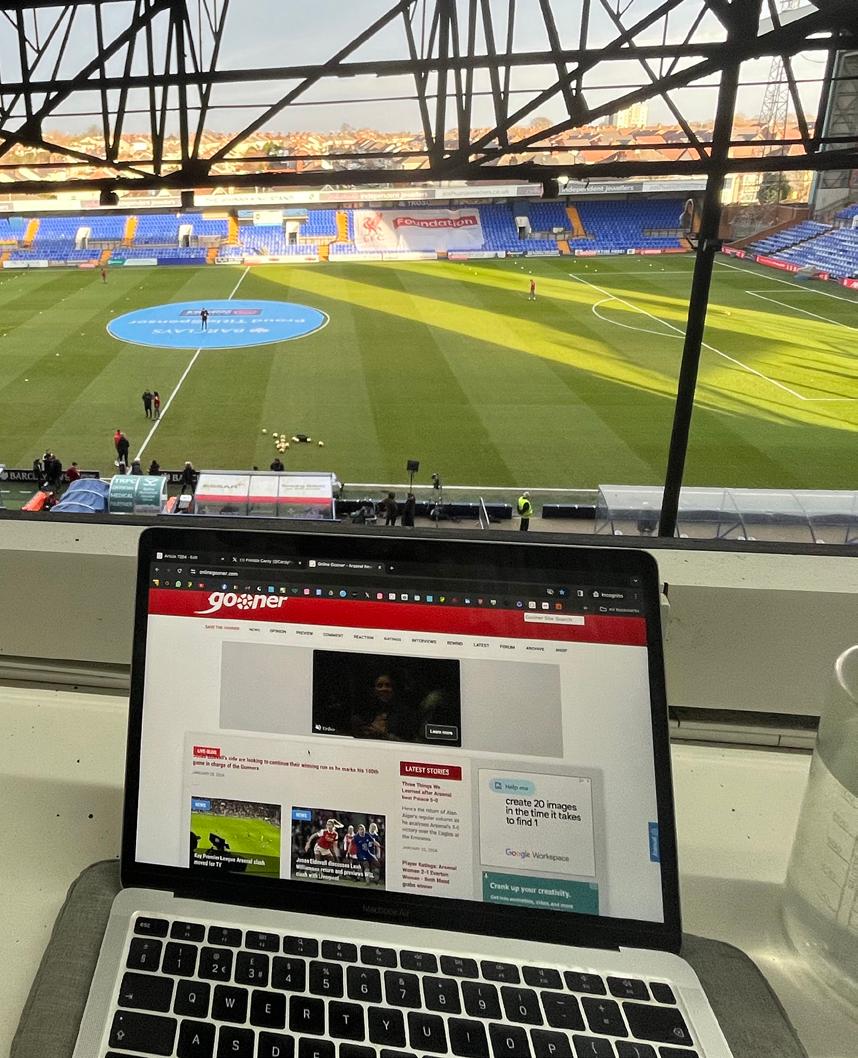
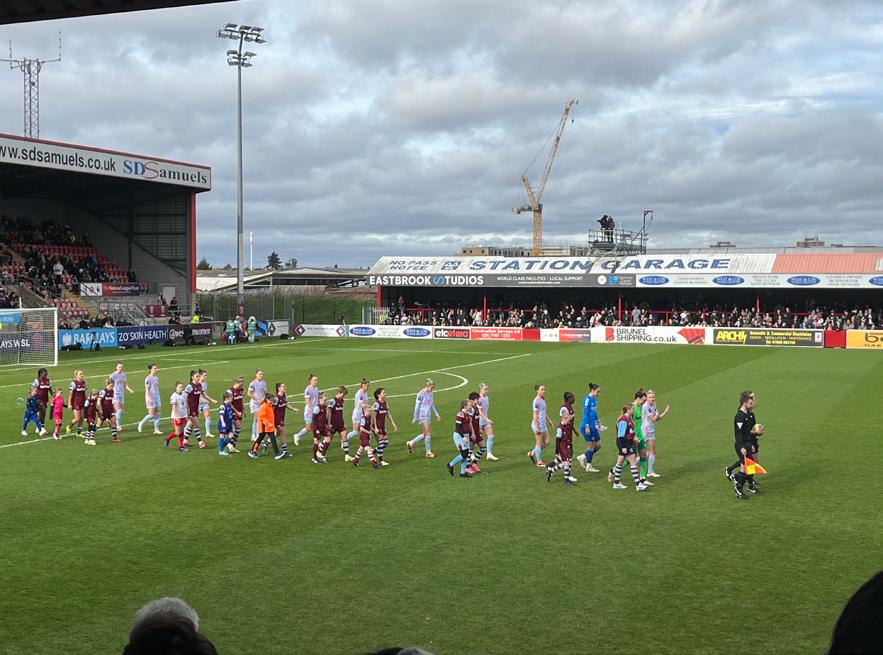
On the plus side, my Gooner Fanzine colleague Rosie O’Leary was able to drive us back home in time to watch the men beat Liverpool 3-1, so there was something of a happy ending.
Sunday February 11: Arsenal v Manchester City (FA Cup)
I’m not a fan of lunchtime kick-offs, and I really wasn’t too keen on this one after a particularly enjoyable surprise birthday party for one of my neighbours the night before.

lost 1-0 to City, who had young goalkeeper Khiara Kheating to thank after a string of impressive late saves.
Did one of her stops see the ball cross the line though? There was no goal line technology to answer that question, and Arsenal were dumped out of the FA Cup in the Meadow Park sunshine.
Saturday February 17: Arsenal v Manchester United (WSL)
Arsenal were perhaps also feeling something of a hangover from the previous week, and
Arsenal sold out the Emirates for the very first time in the WSL, and just the second in the club’s history following last season’s full
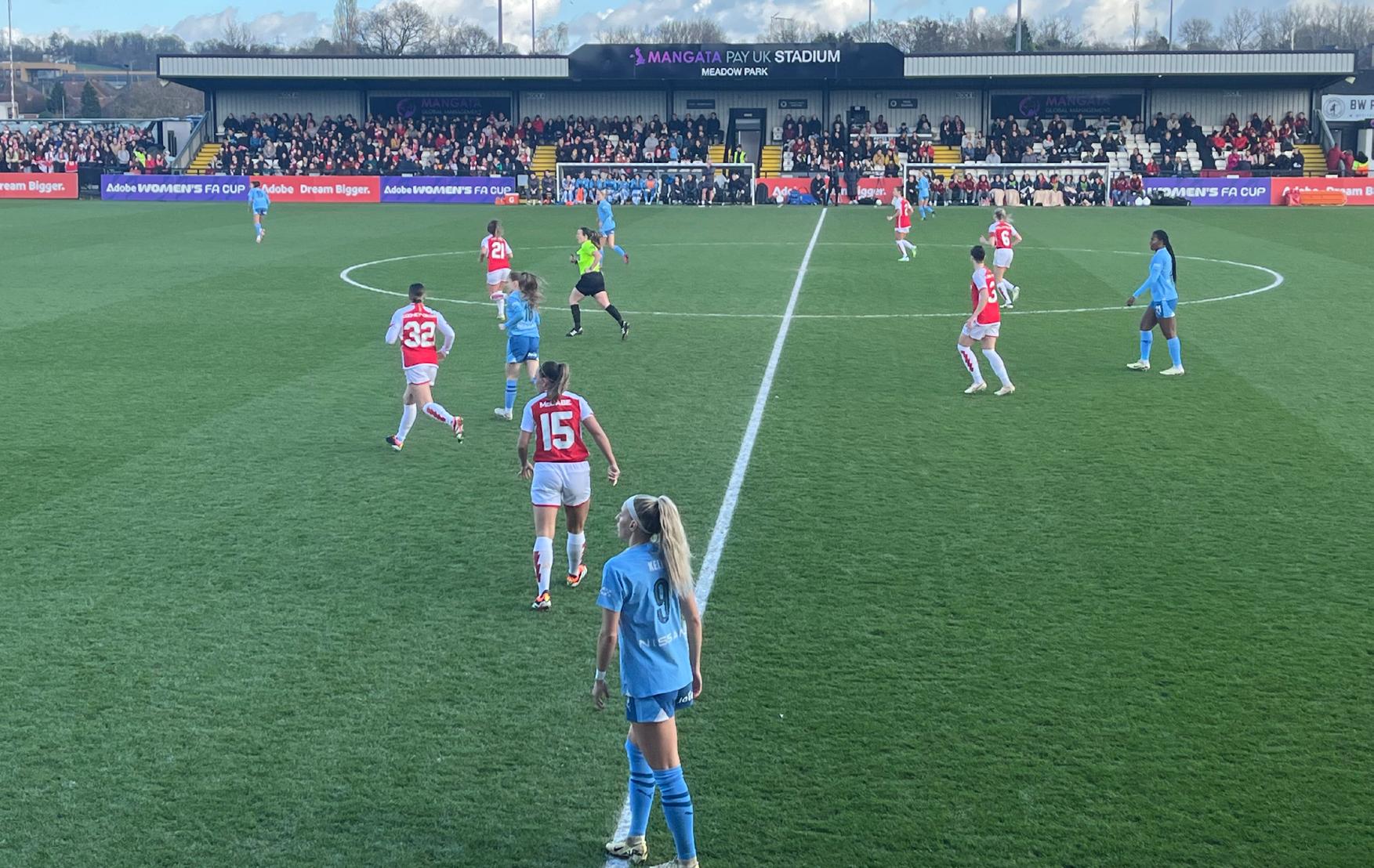

house in the Champions League semi-final. Inch perfect off the pitch, and the result was not far from perfection.
Cloé Lacasse ran the show on the left-wing and Manchester United’s haphazard defence was run ragged in a 3-1 defeat.
I can still picture Kim Little being raised into the air by her teammates after scoring from the penalty spot just before half-time.
This was a result that kept Arsenal firmly in the title race, and pushed Marc Skinner’s side further down the table and ever closer to another season without European football.

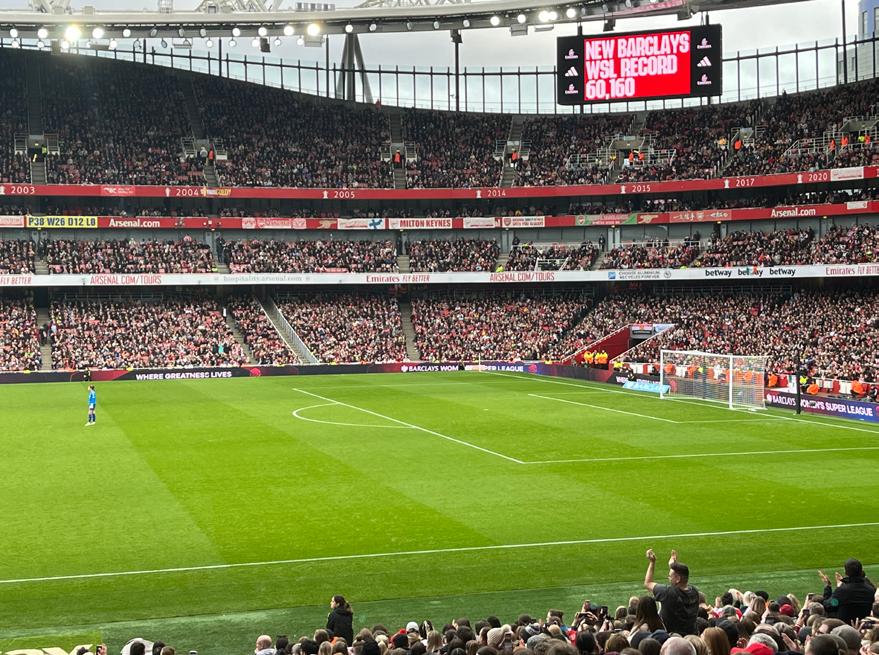
three points.
Sunday March 3: Arsenal v Tottenham Hotspur (WSL)
Another sold-out Emirates meant for another article, this time on the impressive nature of back-to-back sellouts. How long, I wondered, before Arsenal selling out the 60,000-capacity venue would simply not be newsworthy?
It was one of those derby games that lived up to the cliche of the result being more important than the performance, with Alessia
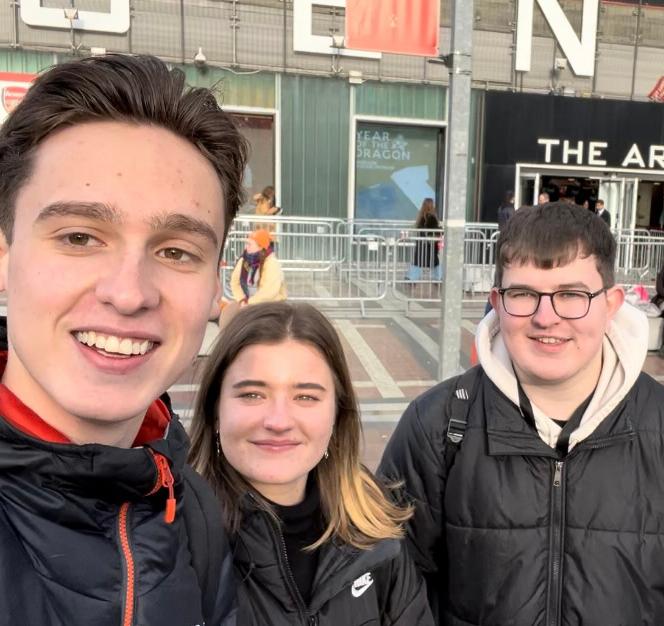
Russo scoring in a narrow win for Arsenal, avenging their defeat on the other side of North London in December.
The good news was that my late train home opened up some time for a post-match drink in the Tollington, who were stocking some copies of the latest Gooner behind the bar. See you there after the Leicester game!
Wednesday March 6:
Arsenal v Aston Villa (Conti Cup)
We will all remember Stina Blackstenius’ winning goal against Chelsea in the Conti Cup final, but the Swede’s blistering firsthalf hat-trick in the semi-final ensured that Arsenal had the chance to claim silverware at Molineux.
Blackstenius blew Aston Villa away at Meadow Park, helping the Gunners to a 4-0 lead after the first 45 minutes. The North Bank had a lot of fun, and so did those in red and white on the pitch. A far cry from Villa’s 2-0 win at the same venue on the final day of last season.
Friday March 15:
Chelsea v Arsenal (WSL)
A miserable Friday night: absolutely soaked by the West London rain on arrival at Stamford Bridge after a seemingly neverending battle with the District Line, and then Arsenal brought the wrong socks.
Jonas Eidevall may have played down the impact of the delayed kick-off, but Emma Hayes rightfully couldn’t hide her glee upon seeing Arsenal wearing Chelsea garments on their feet.
A clear boost for the home side, but Arsenal’s woeful defending meant that they would have lost the game in any kind of clothing.
Yes, Chelsea’s goals were ugly, but Arsenal’s performance was even worse. The 4-1 win at the Emirates was flipped on its head, and the Gunners lost huge ground in the title race.
Credit to Arsenal’s sold-out away allocation who never stopped singing.
Sunday March 24:
Aston Villa v Arsenal (WSL)
The last train to depart Birmingham New Street for Derby was close enough to fulltime at Villa Park for me to choose to miss the post-match press conference, a decision that was made well in advance of travelling down for the game.
This meant that when kick-off was delayed by 45 minutes, this time due to Arsenal’s coach being held up in traffic, it was going to be a nervous evening.
Fortunately for me, I jumped in a taxi with two Arsenal fans straight after the Gunners sealed a 3-1 comeback win, and made it to my train in time. Of course, it was then delayed. I should’ve known…
Despite yet another delayed kick-off, it was an intriguing game of two halves, in which Arsenal eventually rattled off over 30 shots at Anna Leat’s goal. The Villa goalkeeper was heroic, but the Gunners improved after half-time and deserved to travel home happy. Lotte Wubben-Moy’s goal and celebration was definitely a highlight.

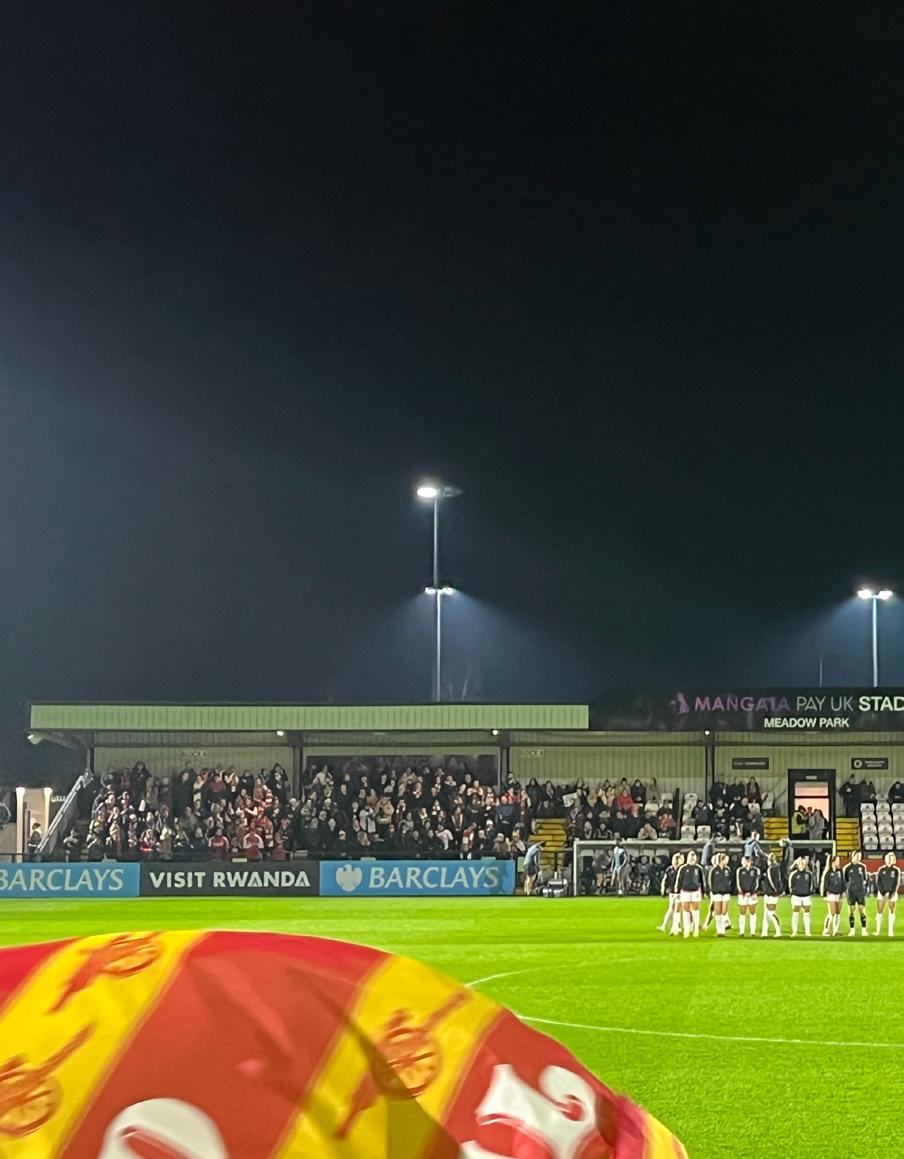
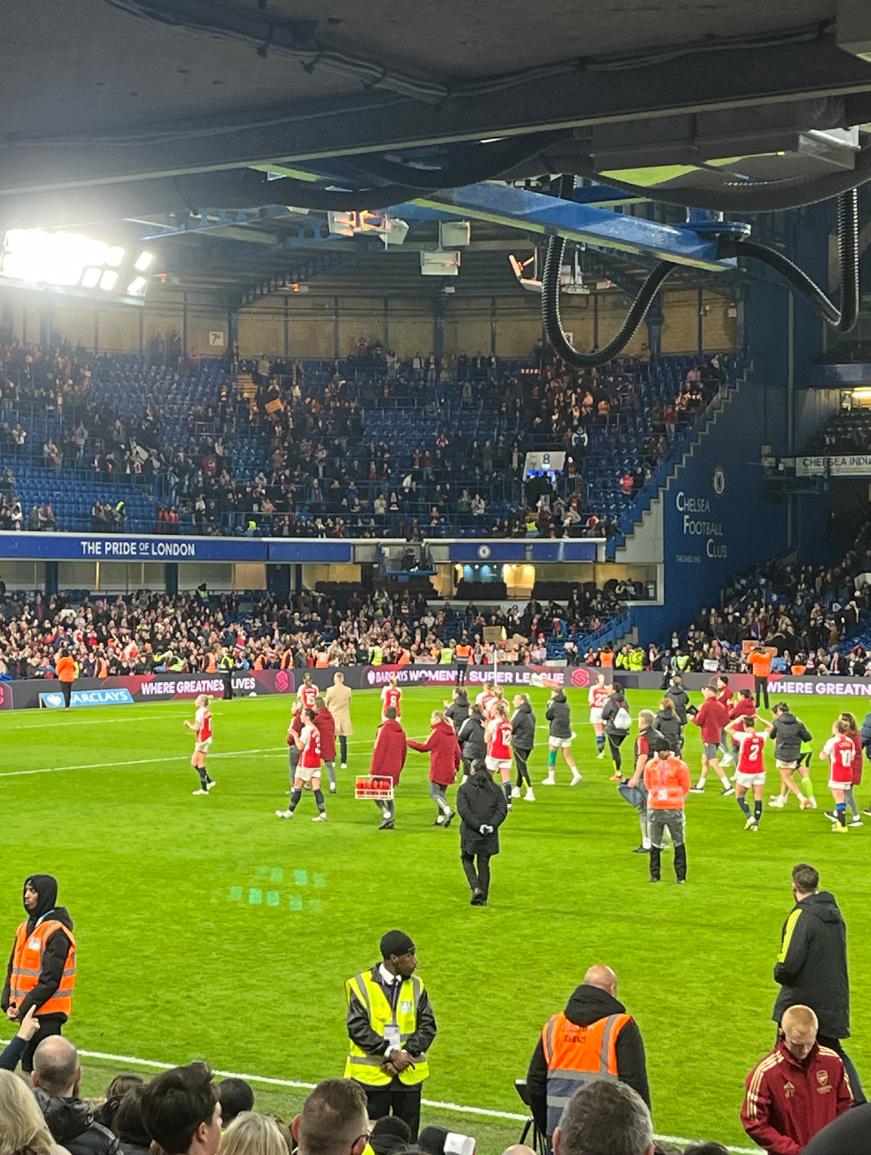
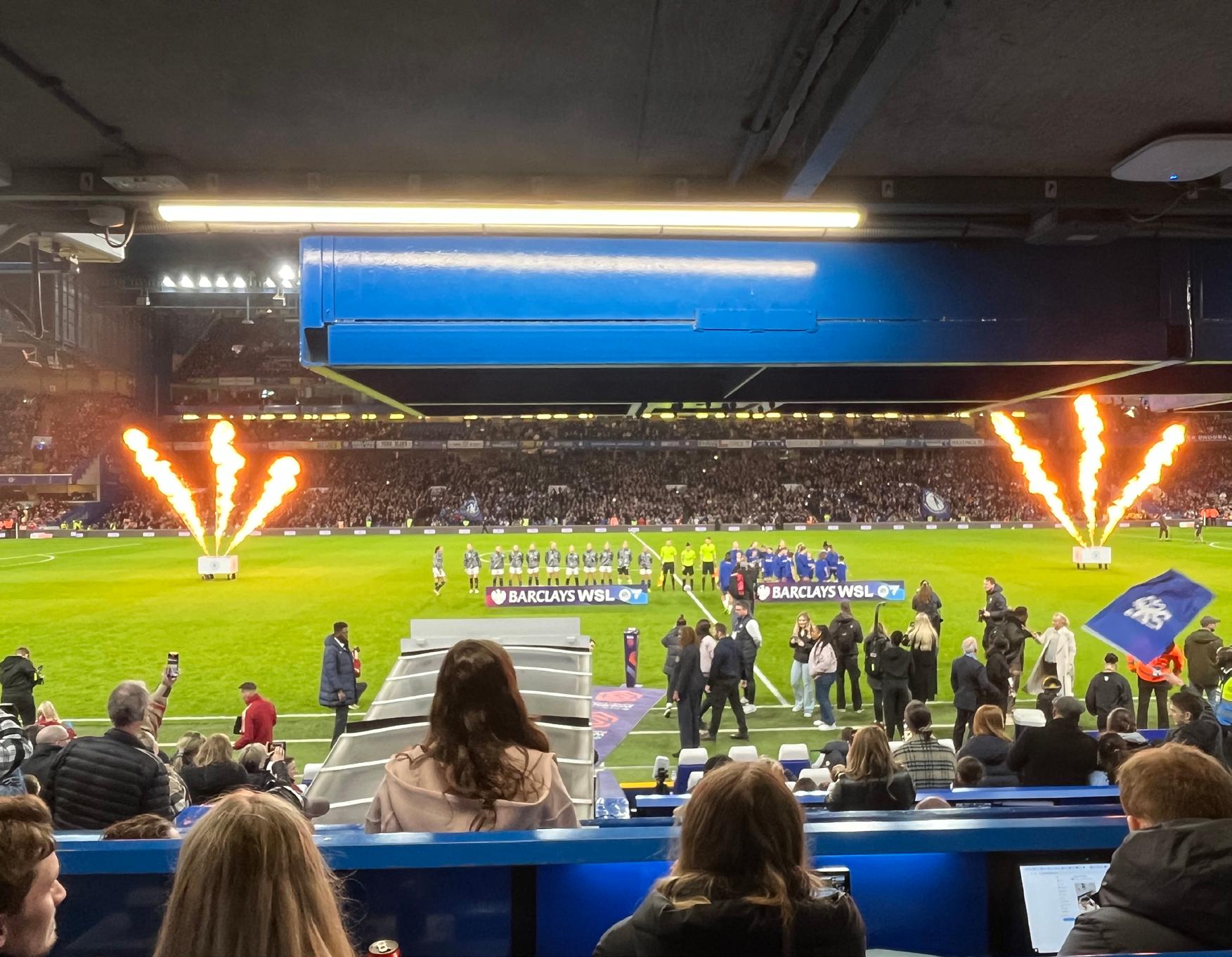

WhenArsenal took on Chelsea earlier in the season in the Barclays Women’s Super League at Emirates Stadium, it was Arsenal that won the tactical battle and came out on top.
Defined as one of the Gunners’ best performances of the season, a major 4-1 victory saw them send a clear message of their league title ambitions.
Yet when Arsenal stepped out to take on Chelsea at Stamford Bridge, a disappointing performance saw a dominant Chelsea earn a 3-1 victory, making Arsenal’s title hopes almost impossible. The two fixtures demonstrated two tactical battles with very different outcomes.
In their 4-1 victory against Chelsea at the Emirates, Arsenal played with an extremely high intensity, from the offset to the final minutes of the game.
Operating in the 4-2-3-1 formation that they have used in almost every game this season, Arsenal wingers Caitlin Foord and Beth Mead looked to exploit the Chelsea fullbacks in oneon-one situations. Playing balls directly to the feet of Alessia Russo, whilst also encouraging her to make runs in behind the backline, Arsenal demonstrated their attacking versatility.
The Gunners were defensively solid –supported by their wingers midfielders coming back to defend and moving centrally or out wide when required.
They crowded the box to allow them to defend set pieces and corners and would press to ensure they covered every Chelsea player.
They would even double or triple up on the Chelsea player who had the ball to force them backwards or cause them to lose possession.
Yet when Arsenal came up against Chelsea later on in the WSL season, the same tactical dominance did not occur, and Chelsea deftly adapted their tactics cleverly to produce a resounding victory.
In some ways, Chelsea played Arsenal at their own game, crowding the opposition player on the ball, playing through the midfield easily and winning loose balls.
Arsenal were shaky from the start, playing poor passes and not moving the ball out wide quickly and accurately.
They failed to play balls in behind for Stina Blackstenius, so their attacking opportunities were limited as a result.
Defensively Arsenal were extremely poor, they looked unsure about player marking responsibilities and this led to errors where the backline were not in sync.
No one closed down the space at the edge of the box, something that talented players such as Lauren James exploited to create attacking opportunities for Chelsea.
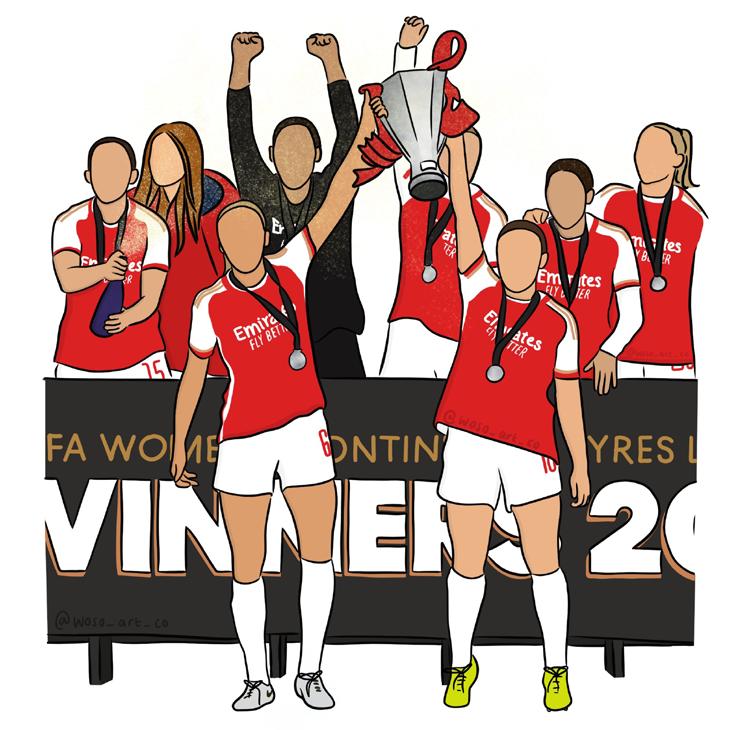
With such differing performances in the two fixtures, the Conti Cup final was set up to be a tactical battle like no other.
Whether the game would go one of two ways or be a battle of fine margins was the thought on everyone’s mind.
Arsenal eventually came out on top with a late winner from Stina Blackstenius, yet the tactical battle between the two coaches was extremely insightful.
In possession, Arsenal were extremely versatile in their attacking play and would look for a variety of different routes through which to get forward.
By exploiting the space that opened up in midfield, Arsenal could move the ball effectively from one side of the pitch to the other.
Victoria Pelova would find space in between the lines to move the ball through the midfield, whilst Frida Maanum could exploit this space to receive long balls into feet and turn to get Arsenal on the attack.

By exploiting the space that opened up in midfield, Arsenal could move the ball effectively
Significant space opened up both in between and behind the players in the Chelsea backline, with Arsenal attempting to exploit this.
Blackstenius would look to make runs in between the two Chelsea centre-backs, and in the latter stages of the game looked to make runs in behind.
When Arsenal got the ball in their attacking third they moved the ball from one flank to the other quickly and accurately, looking to play first-time balls that would enable creation of more attacking opportunities.
Arsenal were looking to play the ball out wide to their wingers, looking to take on the Chelsea

fullbacks in 1v1 situations, with Chelsea not doubling up when defending.
Out of possession the press for Arsenal was also an extremely effective tactic, pressing the fullback when they were on the ball and covering the pass to midfield to force Chelsea back or force rushed passes.
When Chelsea were on the ball Arsenal would close out the midfield, pressing the player on the ball with two or three players to win the ball back.
Winning the midfield battle has proved key in games of this magnitude, and Arsenal did this throughout.
In the final third Arsenal defended the edge of the box, preventing the Chelsea players from creating space for a shot.
By also getting a significant number of players back to defend Chelsea corners, Arsenal could win more of the headers and loose balls. Arsenal remained compact in their shape and defensive duties, particularly in extra time, which helped them keep a clean sheet.
The substitutions were extremely effective for Arsenal; when Foord and Steph Catley came on they utilised their link-up play to get Arsenal in promising situations. It was this link-up play that created the chance for Blackstenius, who gave Arsenal the lead with five minutes to go.
Arsenal did extremely well to bounce back from their disappointing performance against Chelsea, demonstrating more of the dominance we saw in their victory against Emma Hayes’ side earlier in the season.
By adopting the key tactics that worked so effectively for them against Chelsea and executing them in this game, Arsenal were able to achieve the win that saw them take home the Conti Cup trophy.




AsArsenal Women prepare for a postseason trip Down Under, much is being said in regards to the Gunners’ decision to participate in an exhibition clash with the Liberty A-League All Stars at Melbourne’s Marvel Stadium.
The fixture will see the Gunners travel to Melbourne after their final leg of the Barclays Women’s Super League season, gearing up to line up against a collated team of players from Australia’s top-flight women’s league, on Friday, May 25 (May 24 UK time).
A notable cause for concern has arisen in the form of load management, as discussions of validity heat up surrounding the 14 days that separate Arsenal’s final fixture of the WSL, and the commencement of the European Qualifiers to be played on the 31st of May.
Arsenal’s trip Down Under falls directly in between the two scheduled events, as many criticise the strain this may have on the squad as they prepare for a summer of football ahead.
Appreciating the concerns surrounding potential issues that this may cause, it is important to discuss the brilliance Arsenal’s plan to travel to Melbourne will involve for women’s football in Australia.
As the dust began to settle on what was a record-breaking FIFA Women’s World Cup in Australia and New Zealand, an excitable buzz still filtered through the nation of green and gold off the back of a stellar campaign from their Matildas.
Those still reeling with the excitement from the festivities brought on by Tillies Fever, found themselves searching for a greater fix beyond the confines of the home tournament. Thus, their attention turned cross-country, and toward the Women’s Super League.

The fan-named ‘Ausenal’ have taken the most voters, as Australia midfielder Kyra Cooney-Cross made her summer arrival to join compatriots Caitlin Foord and Steph Catley in North London.
The World Cup efforts saw football take a new lease in the nation of Australia, as a sport that has historically garnered so little attention, has finally begun to turn heads.
As Aussies rush to grab their ‘Ausenal’ shirt off the racks in shops, the post-season friendly provides a golden opportunity for women’s football in Australia.
In a nation where the likes of Aussie rules, rugby league, and cricket to only name a few, dominate the attention of Australians across the country, the arrival of Arsenal’s profile will be sure to boost the recognition that football so greatly deserves.
As well as the excitement that surrounds the arrival of the Gunners Down Under, the friendly fixture provides the priceless opportunity that spectators, perhaps coming to witness an episode of the Cooney-Cross show, will also be exposed to a calibre of A-League players that they may normally ignore.
As fans pile through the turnstiles of the Docklands stadium in hopes of watching an electric Alessia Russo, many spectators will tune in to those marking her, and cast their attention toward the footballing talent so very accessible to them, in their very back yard.
Amidst the rising discussions of the postseason trip, one thing is certain:
Arsenal will act as a vessel of inspiration in the promotion of the Liberty A-League, a league of exciting talent that is too often overlooked in the nation of Australia.
Jamie Spangher’s take on the Gunners post-season friendly in Melbourne and what it can mean for Australian football Jamie Spangher @jamiespangher

As the summer transfer window approaches, it is an opportunity for teams to reflect on their strengths and weaknesses.
Taking these into perspective, teams can recruit accordingly and push to better themselves for next season.
With Arsenal hoping to push on all fronts next season, here are my suggestions for who could strengthen Jonas Eidevall’s roster next season.
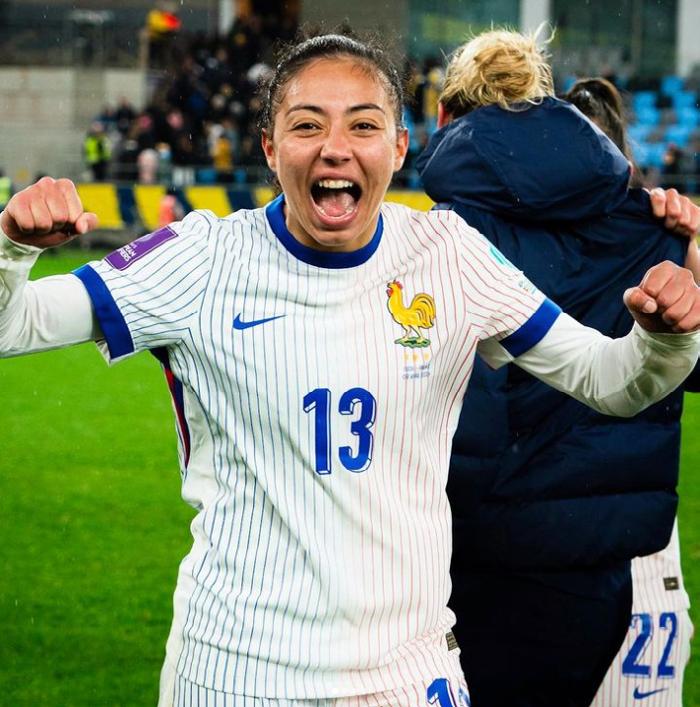
The modern full-back is both defensive and offensive in their style of play. As will become a theme across this list, Selma Bacha can play across many positions out wide, and brings different dynamics to her teams as a result.
The French international has pin-point accuracy on her passes, and easily pops one over the top to find a teammate. A killer left foot, she is powerful and precise, whether she is breaking through the lines or sending in an assist to be delivered home.
Technically excellent, she combines well with her teammates, both in masses of space and in close situations.
Through this, no pass is wasted or mishandled. She is forward thinking and controlled to make each pass and decision pay off to build play down to the wingers.
Interchangeable at fullback and in midfield, and sometimes as a winger, Bacha is a young player with excellent vision and progression.
She has played well alongside past Gunners over in France, but could play even better with a team full of them in North London.

The two time NWSL Defensive player of the year is a big deal.
Naomi Girma has been a central point for both her national team and club since graduating from Stanford University in 2022.
A lively and springy centre-half, Girma is excellent at putting in crucial blocks around the box to protect her goalkeeper.
Agile and responsive, she reads the play to perfection to simply put a leg out to keep the ball away from goal.
Marking players almost completely out of games, Girma is a calm and collected centrehalf, who looks comfortable and at ease defending tough attackers.
A standard ‘brick wall’ defender, the EthiopianAmerican is strong, resilient, and quick to put in crucial defensive actions.
She brings extra edge to the backline, with her small touches and forward thinking. Without trying, she doesn’t push the boat out.
Instead, Girma sticks to simple defensive techniques that bring stability to the team, and allows others to bring the progressiveness across the pitch. Solid and strong, she is definitely a centre-half that could bring an extra edge to Arsenal.

Iceland and Wolfsburg
Arsenal have already seen the abilities of Icelandic international Sveindís Jónsdóttir. Many won’t like to remember the assist and goal she
scored against the Gunners for Wolfsburg last season in the semi-finals of the UEFA Women’s Champions League.
That aside, Jónsdóttir is an exceptional young winger. Equal parts agility and speed, the 22 year-old’s ability to storm down the wing brings a dynamic option out wide. With her quick thinking, Jónsdóttir is lethal in front of goal, providing assists from out wide as well as goals.
With a physicality learnt in Germany, and a height advantage too, the youngster works exceptionally down the wings to bring a new element to a team.
With speed and tight footwork, Jónsdóttir is an effective, compelling, and progressive winger that brings an exciting edge to a team.
Technically great and an eye for goal, the Icelandic international is laser sharp and destructive to defenders.
She would provide some well needed pace and control out wide for the Gunners, adding another exciting dynamism to the squad.
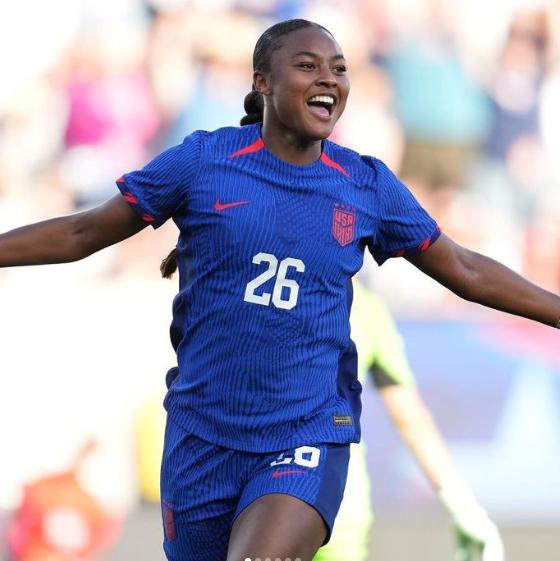
USA and San Diego Wave
The US Women’s National Team has never been without their stars. And leading the next generation is San Diego Wave’s Jaedyn Shaw.
Now in her second full season in California, after going professional at just 17, the 19-yearold is versatile and creative across her roles within the team.
Having the ability to play as a striker, rightwinger, attacking midfielder and central midfielder, Shaw is agile and transformative across her positions.
Quick-thinking and nimble, the USWNT international works well with both feet to create and provide for her teams.
Playing further infield, Shaw has the ability to pop balls forwards, dividing lines with ease and creating clear-cut chances for others. This is where she works best.
Her creativity and skills shine to their maximum ability and she combines across the pitch to also bring the best out in others.
Technically exceptional, with the ability to finish in a number of ways, Shaw would join many a USWNT player in North London, where all have shone. And she could too.
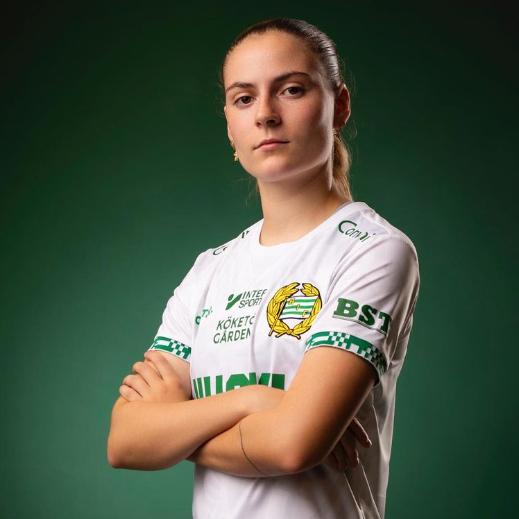
Smilla Vallotto has quickly become one of the most versatile players in the game. In her short career, the 20 year-old Swiss international
has played in a variety of positions across the midfield, but has mainly played at right wingback. However, in Hammarby’s pre-season and Svenska Cuppen campaign, she has played further into midfield.
Her versatility comes in handy across the pitch, with her being able to contribute both offensively and defensively.
Having become a deadly finisher in her attacking role, Vallotto carries the ball through midfield with ease and comfort.
Often finding herself in space, the Swiss international has developed a lethal right foot and can score in a number of ways.
With an acute understanding of her teammates, she links up well with those around her to bring the best out of them.
At The Arsenal, Vallotto would link up with her international captain, Lia Wälti, in midfield. With her versatility and dynamic playing, the Swiss female Young Player of the Year would be an excellent addition to anyone’s arsenal.

To put it simply, Ellen Wangerheim is the future of Swedish football. The 19-year-old mirrors the profile of Arsenal’s very own Swedish striker
Stina Blackstenius exceptionally well. An outand-out striker, it is not surprising the young sensation scored nine goals in six starts last season for Hammarby in the Damallsvenskan, after returning from her Anterior Cruciate Ligament injury.
Casually, six of those nine goals were two hattricks which helped her Stockholm team win the league title.
A sensational finisher, Wangerheim can score centrally and from wider positions across both feet, with the ability to weave around defenders and dictate play her way.
Incredibly strong and resilient, her height, like most Scandinavians, is used to her full advantage, breaking down defenders and controlling play with ease.
Adept with her feet, Wangerheim reads the play well, switching and balancing her footwork to perfection.
Having already completed the double in Sweden, she could move to North London to
win even more trophies with Arsenal, including her future international teammates.
Oh, and did I mention? It’s her dream to play for The Arsenal.
With two consecutive trophies under their belts, Arsenal will be hungry for more next season.
With a good summer window, that hunger could be satisfied. With signing options like these, the dream could easily become a reality, and Arsenal could return to their mega trophy winning ways.
An out-and-out striker, it is not surprising the young sensation scored nine goals in six starts last season for Hammarby



Here’s Meg Lay on being a part of Arsenal’s all female groundstaff for the North London derby and the challenges faced by her industry in this exclusive interview with Freddie Cardy
Lay on being part of Arsenal’s allfemale ground staff for the North London
It goes without saying that Arsenal Women have made remarkable progress both off the pitch in recent years, but their latest landmark came on it.
More specifically, the hallowed turf of Emirates Stadium, when an all-female grounds team came together to curate the pitch ahead of the Gunners’ game against Tottenham Hotspur in the Women’s Super League.
New Zealander Meg Lay was one of those members of the ground staff, and the 27-yearold has added Emirates Stadium to a rather impressive repertoire of grounds.
Having worked in farming back home, Meg moved to Bristol, England in 2023, and joined Gloucestershire County Cricket Club as part of their ground staff.
Now, Meg works at the Home of Cricket, Lord’s, in London, and in March she was part of an all-female grounds team at a sold-out Emirates Stadium.
Meg spoke exclusively to the Gooner Fanzine to reflect on her experience at the Emirates in a wide-ranging interview.
How did the opportunity for you to be part of an all-female ground staff at Emirates Stadium come about?
“About a year ago I saw a video that Arsenal put out about Tara Sandford being the first female groundswoman. We were doing an

all-women’s day in cricket, but there were only three women working in first-class cricket, and so I knew I had to rope Tara into it.
And she was very keen, and off the back of that the FA got in touch with us, and they were very keen to replicate it, and obviously with Tara working at Arsenal, it sort of seemed like the perfect fit. They were fantastic.
Paul Ashcroft, who’s in charge of all the grounds there, he was right behind it, his team was right behind it, and it couldn’t have turned out better really.”
Not long ago you were working in farming back in New Zealand, and now you’re working at some of the top sporting venues in Englandit’s some story…
“It’s totally crazy. If you’d told me even two years ago that I would be working at Lord’s and the Emirates, I would never have believed you.
Meg Derby, and the challenges faced by her industry
“Women need to step up and start helping out, because our female athletes deserve it”

But it’s a really struggling industry. I had experienced farming, and I had studied a bit of agriculture back home in New Zealand, and I had played cricket my whole life, so that meant that I was more than qualified to work at an international cricket ground- which is sort of crazy. It shows how much the industry is struggling to find staff.
I was living with two professional cricket players, and they came home from work one day- this was when I had just moved over to Bristol- and they said the ground staff were really short.
So it sort of went from there, I sent them an email and two years later, I had a really good stint there at Gloucestershire with a good group of guys, and now I’ve ended up at Lord’s. It’s pretty cool!”
What was it like to be a woman working in farming, and how does that compare to groundskeeping here in the UK?
“In New Zealand, farming is very much 50/50. There’s certainly been times where I’ve been the only woman in workplaces, but there’s been places where there’s only been one or two guys as well, so it’s quite different back home.
So it was interesting coming over here and then finding out that it was such a maledominated industry, particularly when all the guys I’ve come across in cricket have been absolutely fantastic.
And they all want more women in the industry as well, but it’s just sort of- how do we persuade women that this is a good career? There aren’t the men that are holding us back,

in cricket certainly. So it’s just trying to promote this industry and getting more women to put their hands up. Because it’s a numbers game, we are struggling.”
As well as an all-female ground-staff, Arsenal also had an all-female tech team working on the Tottenham game, really showcasing the roles that are available for women in sport…
“That’s something that our industry really isn’t great at. We’re really good at talking amongst ourselves- we have lots of turf magazines and that sort of thing, but we need to reach a wider audience, because there are so many people like me who didn’t even know this was a career option. And it is an absolute dream job, and people just don’t know about it.
Women’s sport needs to be played at these top grounds, they need to be training at the top grounds


There’s a lot of people who want to work in sport, and they look at it and think maybe media is the only way in, if you’re not gonna make it as an athlete.
They see the media, and they don’t see all the effort that goes in behind the scenes. Sport couldn’t exist without ground staff, full stop, at any level.
It’s such a crucial role, and it’s such an amazing job, and yet we can’t get staff. And so I think the comms team did an incredible job, really driving the message home that this is a job for women.”
What makes Arsenal stand out in the women’s game?
“You walk in and you feel valued. It’s not like ‘Oh, it’s just the women,’ it is taken so seriously.
I know from a groundstaff perspective, the guys take every women’s game incredibly seriously, and that was just from what I’ve seen.
It seems like such a powerful brand. They’ve marketed the players so well. There just seems to be a really united fanbase as well.
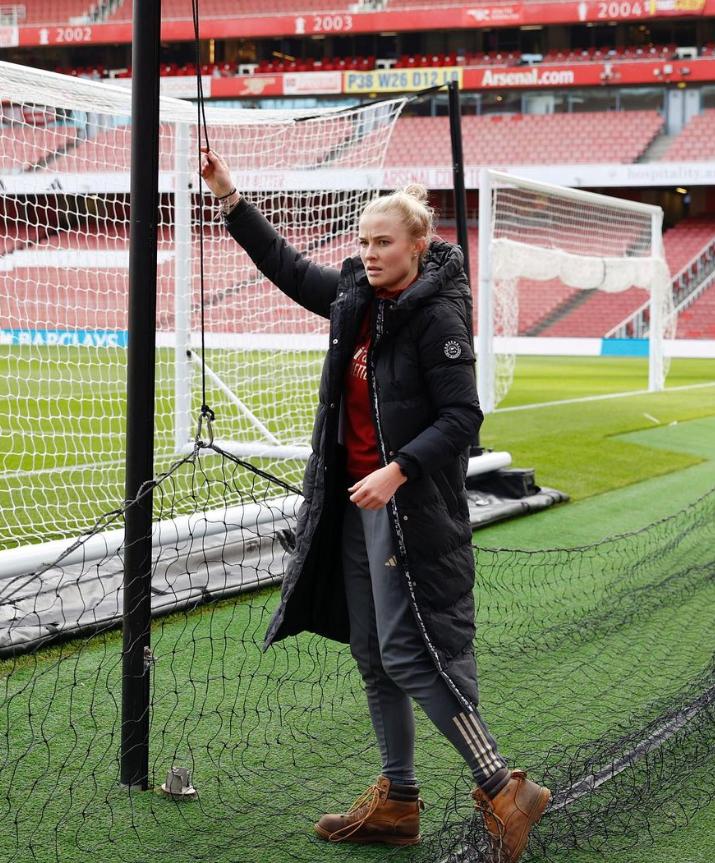
I don’t quite know what the magic is there but there’s definitely something that other clubs need to nail as well, because selling out the Emirates back-to-back for a women’s game is incredible. And they deserve it.”
Did you have any interactions with the players before or after the game?
“No, I didn’t, but I know that Lia Walti went and spoke to Tara, who was in charge for the week, which was so cool.
It’s a job that we spend so many hours doing- I work 70-hour weeks in the summer. I know that during Test matches it’s even more than that. It takes five seconds for a player or a coach or something to walk over and say thanks, or even just ‘hello’.
It does make a difference, especially when you’re pulling these long hours, to feel that appreciation. It was cool to see Lia go over and congratulate Tara, because Tara absolutely smashed it out of the park.”
How does the pressure compare working at cricket and football? The Emirates is nicknamed the ‘Carpet’ after all!


It seems like such a powerful brand. They’ve marketed the players so well. There just seems to be a really united fanbase as well
“It’s totally different. I’ve worked a little bit in football now, I’ve done a few matchdays at Ashton Gate as well, and the pitch is obviously of utmost importance in both games. But I think it’s talked about more in cricket.
It has to be a pretty poor pitch for people to be talking about it in football, whereas if you turn the cricket on on TV, you will be hearing it spoken about every five minutes at least. That’s huge pressure.
The games last for five days as well, and so that’s a big part of the job. More often than not you’re going to get comments you don’t like, because if it’s a great batting pitch the bowlers will be annoyed, if it’s a great bowling pitch

the batters will be annoyed. And so there’s definitely a different set of pressures that come with it. I know that when we did Edgbaston last year I didn’t sleep all week, because I wanted [the pitch] so desperately to play well. I would say football has it easier! There’s definitely a few different challenges, but I really enjoy both.”
After working at a sold-out Emirates, you must be in favour of more women’s games being played at the best possible stadiums?
“Absolutely. Women’s sport needs to be played at these top grounds, they need to be training at the top grounds. But to do that, we’ve got to double our workforce.
We can’t just expect these men to carry on the way they are, putting in double shifts so that the grass is in good enough condition for the women. Women need to step up and start helping out, because our female athletes deserve it.
They deserve the best quality pitches possible and I think that’s up to us to provide that. The men have done such fantastic jobs for so long, and often the pitches aren’t of perfect quality as a result of so much traffic. Then they can get a lot of abuse for that, really, when it’s not their fault- they don’t have enough hours in the day to make the pitch as pristine as it needs to be. They probably don’t have the resources.
Arsenal is very lucky, they’re a big club, but there are Championship clubs and further down the leagues that just do not have the time and the resources.
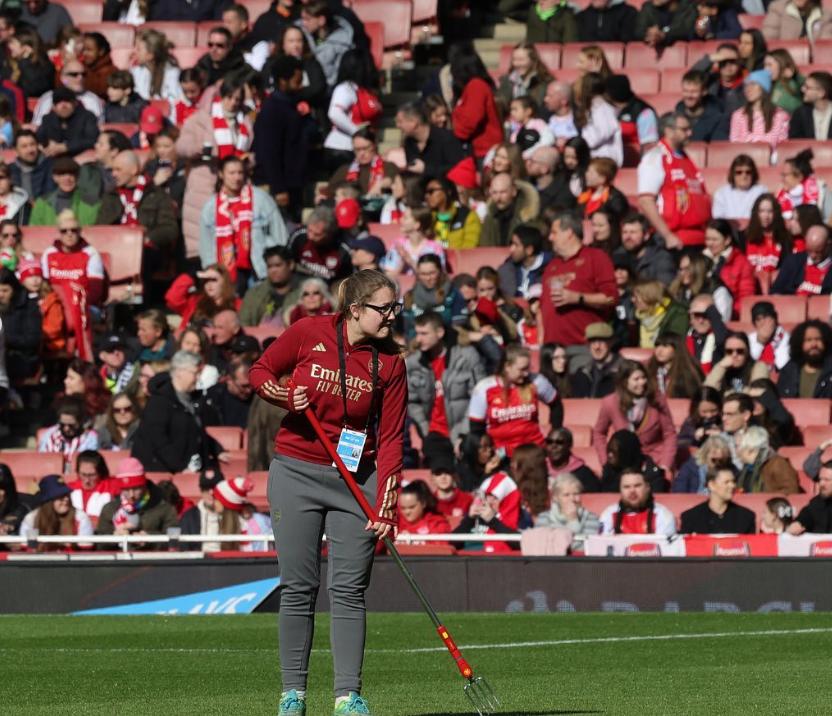
We need a bigger workforce, and if women’s sport is going to be played at these bigger stadiums, the workforce needs to double. It doesn’t take a genius to work out where the rest of the workforce could come from.”
I’m sure many young girls would have been inspired by you and your colleagues at the Emirates. If they were interested in groundskeeping, what are their next steps?
“I spoke to a girl out in New Zealand recentlyshe messaged me and said that she had got in touch with a big stadium, Eden Park, and said she was interested in this role, and they invited her along for an international cricket game, to go and check it out.
That’s the sort of industry it is- we want more people in, and most grounds will do their absolute best to get newbies in, and it’s really important to all of us.
What I love about it is that there’s so many ways in to the industry. If you’re an academic, go to university- do a soil science degree, do a biology degree, horticulture.
If you wanna do an apprenticeship, you still wanna learn, but you wanna learn on the job, you can do that.
Or if you want just do it through voluntary experience, or if you’ve got farming experience, do it that way. If you’re interested in learning more there is the Grounds Management Association, they have a website which will put you in all the right directions.”


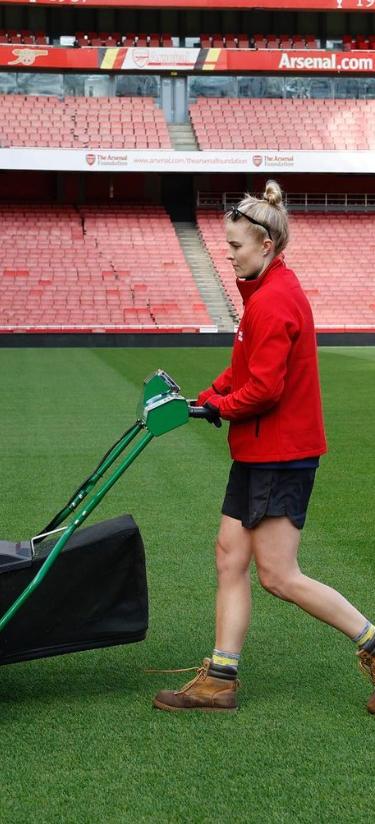
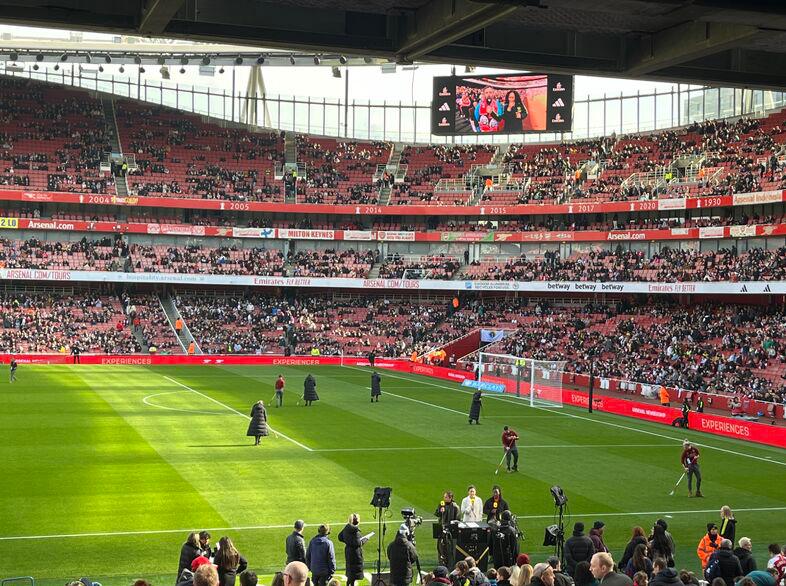

It’sno secret that Arsenal Women have mastered the art of attendances in recent years. Last year’s semi-final against VfL Wolfsburg gave us a hint of what to expect from a sold-out Emirates Stadium, and we’ve since been lucky enough to experience it twice more.
Regular fixtures at bigger stadia are fundamental for growing the women’s game.
It is not just about giving players the stage they deserve - it is about improving the experience for fans, and facilitating easy access for as many people as possible.
That will, in turn, serve as a catalyst for the growth of the women’s game right across the length and breadth of the country.
Seeing 60,000 fans flood through the turnstiles in N5 on a WSL matchday will never grow old, nor will hearing the chorus of North London Forever ring out around the North Bank before kick-off. It has been nothing short of incredible to see other clubs across the league bringing in huge crowds, but the matchday experience extends far beyond those ninety minutes, and that’s the secret that seemingly only Arsenal hold the key to.
It is perhaps a consequence of England’s success at the Euros, given the number of Lionesses currently playing for Jonas Eidevall’s side, but regardless of the reason, thousands of fans are now turning up week in, week out and contributing to the growth of women’s football.
Playing so often at the Emirates has allowed the Gunners to make it home - after all, more than half of the club’s home league fixtures will have been played in N5 this season. With fans growing accustomed to Emirates Stadium, prematch and post-match rituals begin to appear,
akin to those that have been established at Borehamwood throughout the years of calling Meadow Park home.
The matchday experience starts long before you ascend the stairs at Holloway Road, traipse the slope at Arsenal or make the walk from Finsbury Park.
As someone that commutes from outside of London, platforms are adorned with the famous red and white as far away as Bristol - with further waves of fans boarding the train at every subsequent stop before they congregate to form a sea of fervent support in N5.
It ends in an outpouring of fans - some of whom will congregate outside the players’ car park, some of whom will head straight for the pub to celebrate a win, or drown their sorrows after a loss.
Some will leave five minutes early to dodge the queues for the tube, some will stay behind to clap the players off the pitch. But regardless, sixty-thousand fans have made a statement. Women’s football is on the rise, and Arsenal Women are at the very heart of it.
 Rhys Webb analyses Arsenal’s attendance figures
Rhys Webb analyses Arsenal’s attendance figures
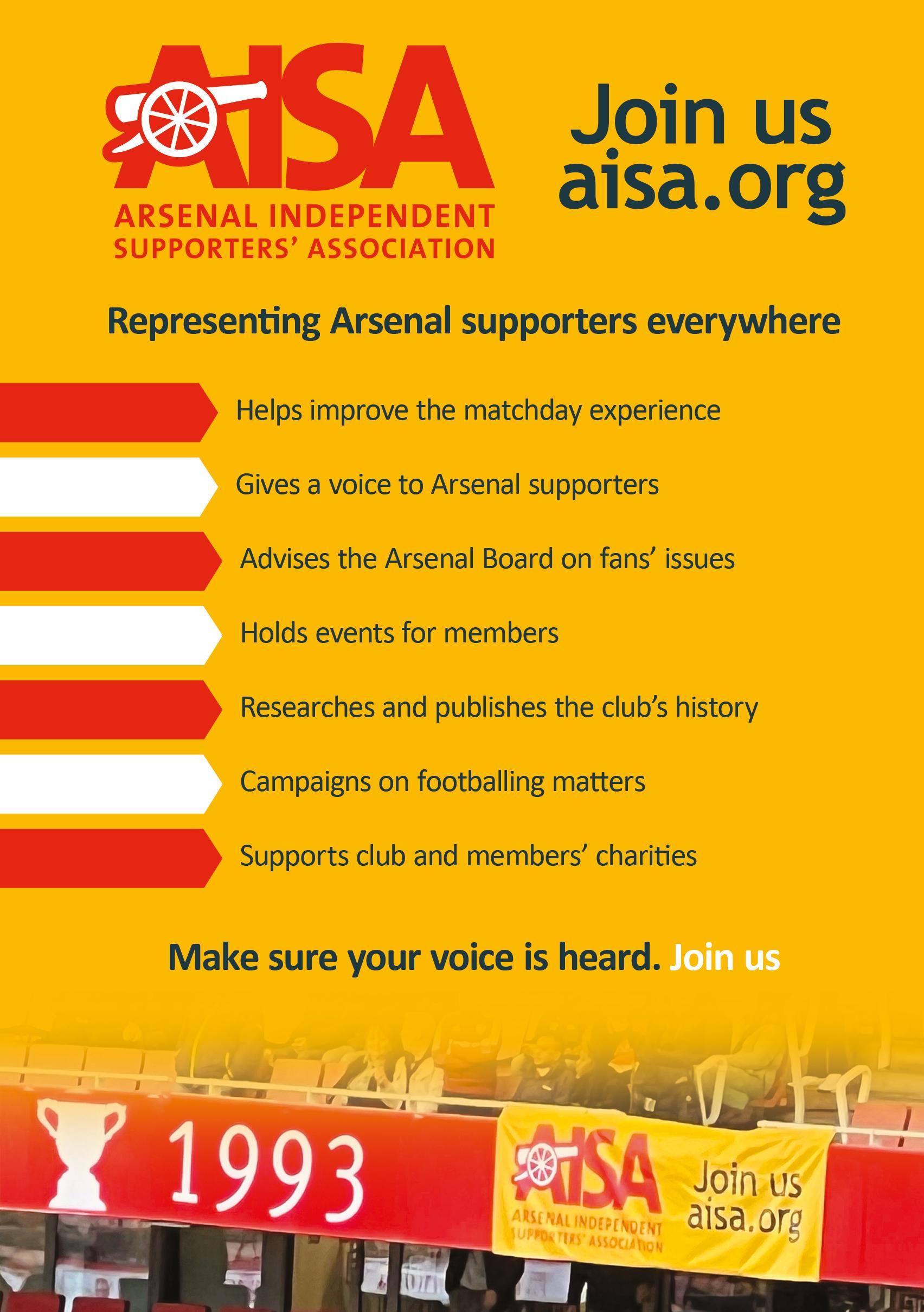
Ithink I knew that I was in fact truly in love with the women’s game some six or seven years ago.
Leah Williamson was substituted and instead of trudging back to the bench, came across to the touchline where she moaned to supporters about the referee!
Or was it watching Daniëlle van de Donk sliding a pinpoint pass into Vivianne Miedema? They were indeed golden days, but quite different from today.
Back then, we were asking how a team wearing Arsenal colours could be emerging onto the pitch from a set of portacabins, but the manager at the time, Joe Montemurro, was telling us that he didn’t want to move as he preferred a packed-out Meadow Park than 59,000 empty seats at the Emirates.
He told us this, answering a question from a supporter at a members’ meeting back in 2019.

And who are ‘we’? We’re AISA – Arsenal Independent Supporters’ Association. We’ve been going since 2000 and campaigned for the women’s game since before Kelly Smith was an inspirational guest speaker at an AISA event a few years ago in 2018.
At men’s level, we have representation on the Arsenal Advisory Board (AAB, with the club’s owners and executives), and we are also a part of the Supporters’ Forum.
For some time, we argued that these did not fully support the followers of the women’s game. Whether by our lobbying or just because it was the right thing to do, we’re pleased there’s now a Women’s Supporters’ Forum - and we are vocal members of that.
What all supporters’ groups have in common is a love of football and a love of Arsenal. Groups like AISA exist because those sitting in the offices at the club sometimes need to hear independent opinions, not just those from paid
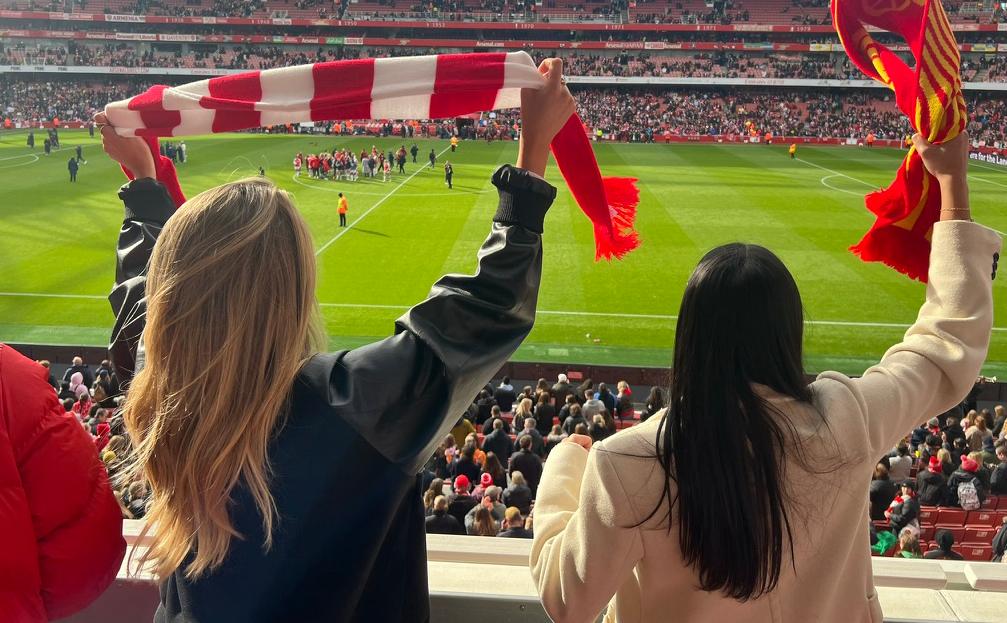
consultants or made through assumptions by those inside whatever passes for marble halls these days.
When we carried out a survey with AISA members a while back – including asking about the atmosphere at Emirates and Meadow Park, ticketing, and support of a Foodbank - and passed on the results to the club, the club asked us for more details – and how many respondents we’d had.
Emphasising there’s a real reason for being a member of a supporters’ group. Not only can you make your voice heard, but you can also have it heard with the weight of one of the biggest supporters’ groups around. If you’re new to supporting the women’s team and don’t belong to a group, do think about joining one of us. It can really make a difference.
Of the things we’re currently campaigning about is the paucity of toilet facilities for women supporters at the grounds. The game has been so male driven that no thought seems ever to have been given to there being a stadium with at least as many women supporters as men. Quite how it’s going to be resolved, we’re not sure yet, but it really must be addressed and can’t be just flushed away.
What we have resolved with the club are queries on a range of issues concerning our members – like ticketing, website, disabled access - while we campaigned successfully for the size of carry-in bags to be increased. It was initially set at no more than A5 size, but the club needed to be reminded that a laptop or rucksack is bigger than that.
The regulation was changed without demur. And perhaps that’s a hidden success of supporters’ groups like AISA. The teams now running the administration within the club seem much more aware of what it’s like to be a paying customer and prepared to listen. They seem now to respect our opinions, whereas previous management styles had us as just extremely annoying amateurs!
So, we’ll continue to press to improve the supporter experience. We are also involved at
a higher level of club operations (at the AAB) and have been involved with the Football Supporters’ Association (FSA) in discussions over the Government Football Regulator.
But at the end of the day, what counts is how it feels to be a supporter, turning up on match days and having a great experience. And that’s what we are working tirelessly on to maintain and improve.
The rest is what the players do between kickoff and final whistle, and we can’t legislate for that sadly!


The Arsenal Supporters’ Trust brings together supporters of Arsenal Football Club with the goal of widening and deepening supporter involvement.
We believe passionately in taking a custodianship approach to the future of our club and believe that this starts with good governance of how the club is run.
The AST is one of the leading supporter groups all across the country with regard to campaigning in and advising on women’s football.
The AST continues to grow its involvement in what has been a recordbreaking year for Arsenal.
Selling out the Emirates Stadium for the Champions League semi-final against Wolfsburg in May 2-23 and setting Women’s Super League record attendances multiple times over the course of the 2023-24 season.
In 2022, the AST submitted representations to the independent review of women’s football led by former Arsenal midfielder Karen Carney.
We were the only supporter group to submit representations to this review, and we were pleased to see a number of our recommendations adopted and endorsed in the final review and the government’s response in December 2023, which emphasises the importance of fans to the sustainable growth of the game.
The AST is represented on the Football Supporters’ Association’s Women’s Game Network, regularly contributing to meetings with key stakeholders in the women’s game.
The AST was pleased to see Arsenal launch the Arsenal Women Matchday Forum for 2023/24, on which it has a reserved spot, and continues to work with the Arsenal Women’s Supporters’ Club on key operational issues.
Finally, a group chaired by Arsenal CEO Vinai Venkatesham on the future of the women’s professional game resulted in the creation of NewCo, a new independent body that will run the elite game, taking it out of the purview of the Football Association.
The AST has consistently asked Vinai and the Club about future developments in the women’s game at meetings of the Arsenal Advisory Board, emphasising the importance of the pyramid, and was pleased to have met with Nikki Doucet, the CEO of NewCo, in 2023.
The AST regularly hosts members’ meetings with updates on how Arsenal Women are getting on and hearing from leading journalists.
There has never been a bigger opportunity to shape women’s football than 2024, and the AST leads from the front. Join us in continuing to attempt to make a difference.
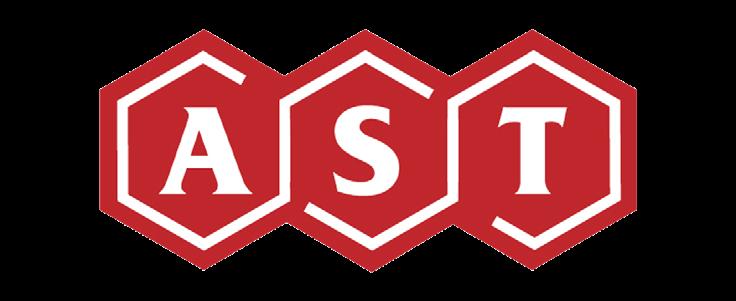
For just £20 annually, you can be a voice in making Arsenal a stronger club with true custodian values.
You can attend meetings with guests including representatives from the club, football experts and leading journalists. You’ll get the latest news on all supporters issues at Arsenal and a full overview on club finances.
The most important poart? You’ll be a voice that is actually heard by the club. Our surveys, meetings and feedback forms give you a direct input to the Fans’ Forum and Advisory Board.
The proof is in what we have already done:
Helping to stop the European ‘Super League’
Securing Government support for independent regulation of English Football. Safe-standing to be introduced at the Emirates Stadium for match-going fans, including facilities and atmosphere.
More than £45,000 raised for the Arsenal Foundation and Islington charities.
And we won’t stop there. Be a part of the club and its future. Be more than a fan.
To join the AST from £20 a year, go to: www.arsenaltrust.org/join

Arsenal’s victory in the Conti Cup final against Chelsea wasn’t just another normal victory. It wasn’t just one more title.
Arsenal needed something to hold onto in a season that has been irregular.
The team was knocked out of the Champions League and they had some setbacks with injuries. They’ve also experienced humiliations like the one they experienced against Chelsea when a problem with socks delayed kick-off.
A problem that became a meme around the world. The players needed to bang on the table and take a step forward and there is not a better way to do it than winning a final against Chelsea, the best team in the league.
“You take away the trophy, beating Chelsea in itself in a top season that they’re having, particularly coming off the back of the disappointing league loss, this was so much more than just a cup win,” Lotte Wubben-Moy said after the match.
“It was a win to show what we’re made of,” added the Arsenal centre-back.
Arsenal is made of young players that have understood since day one what the team is

about. There are players that have grown up in the club since they were little girls, like Leah Williamson and Wubben-Moy.
Who are instilling in the young and new players the feeling for the club. I would say that the respect the players show for the club is one of the things that fans like the most.
I thought it was a very powerful image when the players hugged each other and they sang “North London Forever” in front of the big wall that the fans created in Molineux Stadium.
Not every team has that union.
The fans have never failed despite the ups and downs that the season has had so far.
Even when the team failed, the supporters responded by breaking attendance records at Emirates Stadium.
They never failed, neither in Meadow Park, consistently selling out tickets, nor in the bigger Emirates Stadium making history.
They don’t hesitate to travel miles when the team plays away and they don’t lose hope despite the fact that Arsenal has been in a continuous ‘I want but I can’t’.
 Nagore Dominguez on the importance of Arsenal’s Conti Cup final
Nagore Dominguez on the importance of Arsenal’s Conti Cup final


 Read Claudia Loy’s summary on the season far Claudia Loy @Clauds93
Read Claudia Loy’s summary on the season far Claudia Loy @Clauds93
With Arsenal Women having won the Continental Tyles League Cup for the second season in a row at the end of March, it seems fitting and appropriate to look back on Arsenal’s 2023-2024 campaign and uncover the lows, but also the highs.
This is not to say the season is ‘over’Champions League football still needs to be secured and games need to be played, but realistically Arsenal will finish third.
The gap between Arsenal and fourth-placed Manchester United is too big and it’s unlikely we will climb to second. So competitively, the season is winding down.
On the pitch, it’s been a turbulent, and difficult season at points for Arsenal. But there have been many beautiful moments off the pitch. It has been emotional, that’s for sure.
The connection between the players and the fans has never been stronger, and our attendances have been through the roof. We have set the standards off the pitch and broken so many attendance records.
There has also been a real effort to include new players in the chants, and just generally make them feel at home.
We’ve had players coming back from ACL injuries which has been emotional as well. The receptions they’ve received have been absolutely amazing.
We still have Laura Wienroither to come back, which will happen between me writing this and the end of the season! Amanda Ilestedt is also pregnant, which is lovely.
The season started with us being knocked out of the Champions League.
Coming straight off the back of the World Cup, the players hardly had time to play together and work with all the new signings before these important fixtures.
I think we have struggled to find a rhythm with such a big squad full of talented players all season, though.
We were brilliant against Chelsea at home; that was our best performance of the season, but we haven’t beaten some teams that formed a low block against us.
The recent Aston Villa away game was a bit of a turning point in that sense, I hope. In the second half, we blew them away and created so many clear-cut chances. I hope this continues.
My highlight of the season has to be the Conti Cup final. The fact that the group won it for Frida Maanum, how passionate the fans were, and how much we needed the win,

all made it amazing. And the fact that it was against Chelsea, of course.
In terms of the football, we’ve played better, but the competitiveness and intensity off the ball that the group showed in that final really impressed me.
I hope this remains the same for every game going forward.
Player wise, I think Victoria Pelova, Lotte Wubben-Moy, and Emily Fox have really stood out to me.
Fox has brought some real pace to our back line, on top of her many other qualities which I could go on about for ages.
Wubbey-Moy has been incredibly good and consistent. She is much improved and probably our player of the season for me. Pelova has
consistently been a vital player in the team, as well, and I just really enjoy watching her.
This season I think we’ve lacked a bit of rotation in the wide areas to give Beth Mead and Caitlin Foord a rest.
Going into next season, a couple of additions in key positions such as the wide areas, quality not quantity as Jonas Eidevall put it, will hopefully push us on.
A more settled squad will help, as will more time to prepare for the season and hopefully fewer disruptions with people coming back from ACL injuries, for example.
We didn’t really have a pre-season last year after the World Cup, so if we don’t recruit heavily in the summer, that will give the squad a chance to work on patterns of play with the current group. I’m proud to support this team.


The Continental Cup Final 2024 was held at Molineux Stadium in Wolverhampton. “Neutral territory” in theory; far from neutral, in practice, as it turned out.
Last year’s final was a stepping stone to where we are now, built on the foundations of a long-standing club and team history to be proud of. That final saw our first fan walk, starting with a gathering in a pub mere minutes from the stadium.
This time, our planned, pre-game pub quickly filled up, and spilled into the street, disrupting disgruntled locals going about their business.
The quiet Wolverhampton city centre at midday on Easter Sunday rang and echoed with the chants of Arsenal supporters.
For the fan walk, a tidal wave of Arsenal fans lurched into motion, scarves whirling and voices raised. Did the person at the front know where they were going? Vaguely, but we had more important things to focus on - such as being as loud as possible and letting Chelsea know The Arsenal had arrived.
The players came out, the light show flickered, and the players took the knee. Singing North London forever on kick-off at away games is unique to supporters of the women’s team.
We want our players to feel at home, wherever they are. This game was no different. So, we sang it, mixed with the cheers accompanying kick-off.
From the first minute, we celebrated every save, every tackle, the VAR decision that went our way, like a goal. We cycled through player chants. We pulled out the old classics, carried over from men’s football, the club chants that everyone knows.
The first half passed quickly - but with no goals that stood. So, into the second half we went. A similar affair. Some chances, some misses, but evenly matched.
Then, Frida collapsed to the floor, no other player near her.
The stadium fell silent. More than 20,000 people in utter stillness.
From screaming and yelling and singing to nothing. The passion fled, leaving behind simply a sense of helplessness, settling over the stands like a blanket smothering flames.
A lone chant started from the Chelsea stand and angry cries rang out: “show some respect.” The stewards and security moved up into the stands to make sure that the anger stayed contained.
The minutes stretched out. Frida was moved onto a stretcher. We sang her song in support.
And then, incongruously, we had a game to finish. The match restarted, with the fans and players alike lacking energy. How the team continued to play at all astounds me.
Mere minutes later, the whistle blew, and we were into extra time. A moment to take stock, to reassess. On the pitch, yes. But in the stands too. We needed a spark. We needed something to get us and the team through. North London Forever felt right.
At the restart, in unison, we sang with more passion and feeling than before, scarves aloft, over our heads. This was a battle cry to our team, to show them that we were behind them.
The rest of the stadium was quiet, and our song broke through, as choir-like as a football crowd can be.
This second time around, we wanted North London Forever to remind the team of the sense of togetherness that rallied them last year to reach the semi-finals of the UWCL, despite injuries.
The news that Frida was stable was happily passed around the stands and to the players out on the pitch.
From our perspective, that seemed to galvanise them, to get the win for her.
And then, Stina Blackstenius, ever reliable, sinks a goal with mere minutes to go before the dreaded prospect of penalties.
After more than 120 minutes of football, we had climbed a mountain, the team and the supporters, together.
Bodies tumbling over seats and strangers hugging. In that moment, I understood what ‘limbs’ truly meant.
That’s all I could see, a field of arms and leaping faces. I caught glimpses of the players
between flags and scarves and hands, and the release of tension was mirrored on the pitch.
Full-time. Most of the stadium erupts. Of course the ‘neutral’ section was mainly Arsenal fans. We are massive, as the saying goes.
The celebrations were special. An initial outburst of dancing to all the upbeat player songs. The medal ceremony and trophy lift.
Then the team headed back to the crowd, to the Arsenal end, to continue to celebrate the victory with us.
After a time, familiar chords rang out.
The team lined up, facing us, for North London Forever.
We sang it to the players, and they sang it back to us.
“Highbury Clock End”, said Lotte WubbenMoy, captioning a photo of the moment, with the sea of scarves held aloft as the players looked on. A lifelong Gooner. She would know.


Withan impressive track record boasting 15 League Titles, 14 FA Cups, and being the sole English club to clinch the Women’s Champions League, Arsenal has stood as a dominant force in English women’s football since its establishment in 1987.
In the midst of increasing interest in women’s football, sporadic surges in attendance, and record-breaking television viewership, Arsenal stands out this season as the team consistently filling stadiums across the UK, particularly their 60,000-seater venue in north London.
Arsenal’s early backing of its women’s team has placed them ahead of their competitors in terms of market share and fan base.
As success in women’s sports grows, more media outlets are eager to cover this evolving landscape.
In fact, in recent years we have seen a significant increase in coverage of women’s sports, with it expected to continue to expand, as noted in a study by Durham University.
This brings me to my role within this dynamic realm. Working for BBC Radio London, I’ve witnessed a surge in broadcasting the women’s game this year.
Each weekend, our station airs live coverage of a WSL game, selecting matches based on their significance.
Given Arsenal’s prominence, I often find
myself covering their matches, whether at Meadow Park or Emirates Stadium.
My responsibilities range from providing updates on goals and key moments into commentary of a men’s Premier League or Championship game.
Post-match includes conducting post-match interviews with managers and players.
Additionally, social media plays a crucial role in my work as a journalist, facilitating the dissemination of coverage through score updates, manager quotes, and analysis pieces.
Moreover, the coverage doesn’t end with the final whistle. Throughout the week, our sports
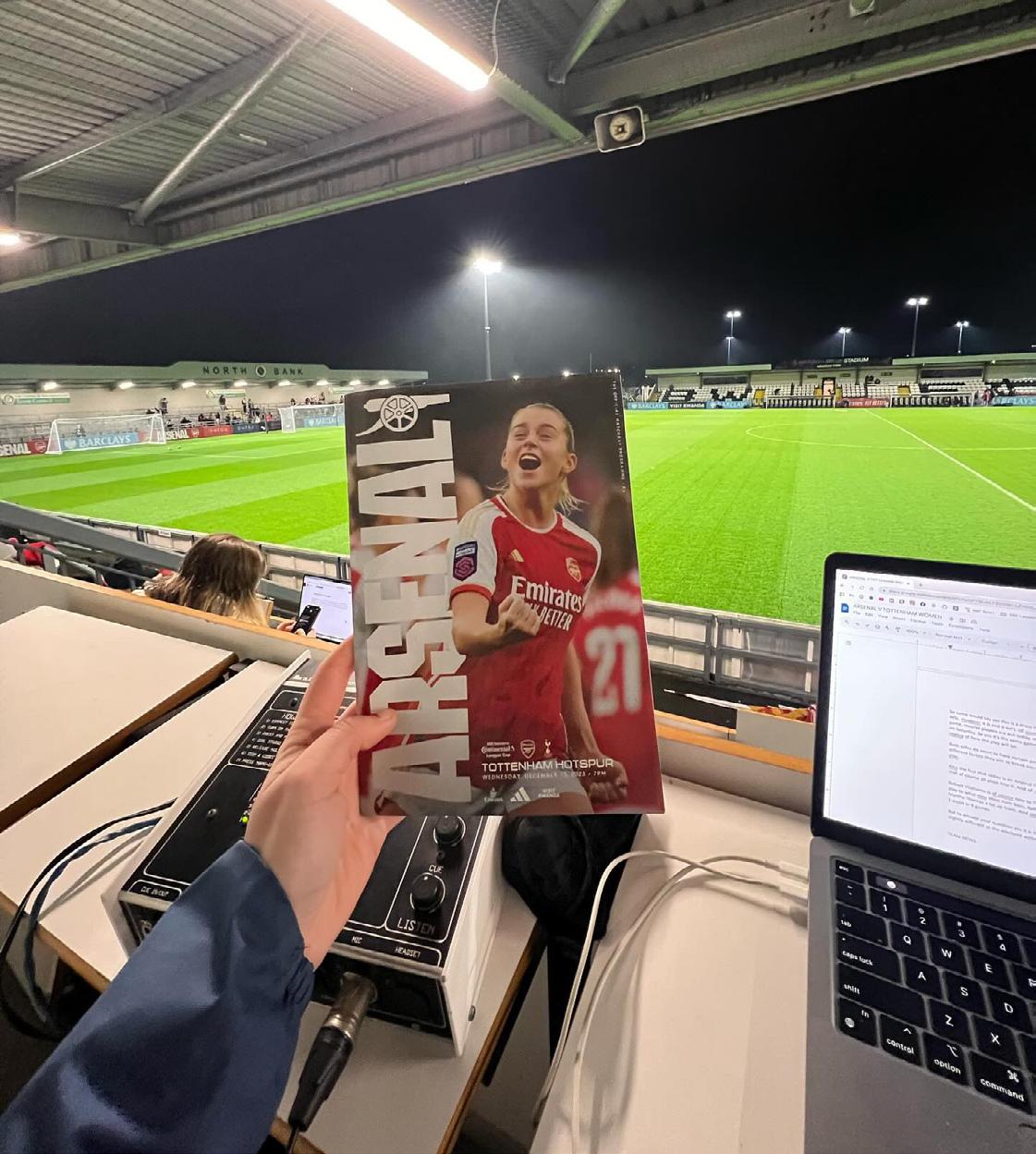 The rise in media attention for Arsenal from a radio reporter’s perspective
The rise in media attention for Arsenal from a radio reporter’s perspective

shows feature dedicated segments on the women’s game, discussing significant results, managerial remarks, injury updates, and more, all broadcast live on air.
The focus of much discussion this season for Arsenal has been the utilisation of their ‘home’ stadium, Meadow Park.
While Meadow Park retains its nostalgic charm and echoes past successes, practical limitations such as having only four operational ISDN lines for radio stations and limited access to press rows make it increasingly impractical for a club of Arsenal’s magnitude, especially with the growing interest from media outlets.
The club has seemingly outgrown Meadow Park at a faster pace than anticipated, despite signing a new 10-year deal with National League Boreham Wood side in 2017 for the women’s side and men’s development teams to continue playing there.
Considering the significant progress women’s football has made in the past decade, perhaps it’s time for Arsenal to consider a permanent
move to Emirates Stadium. Sharing the limelight with the men’s team no longer seems like a distant aspiration, and could potentially inspire other clubs to follow suit.
The current momentum and excitement surrounding Arsenal, with both the men’s and women’s teams performing exceptionally well, make this a propitious moment for such a transition.
Arsenal has already broken the WSL attendance record twice this season, with 47,367 fans attending the North London
As success in women’s sports grows, more media outlets are eager to cover this evolving landscape

Derby against Tottenham Hotspur, following a staggering 59,042 attendance for their game against Chelsea.
Arsenal’s popularity surge can be attributed to various factors, including star power, marketing efforts, as well as a unified branding approach, to name but three.
Individual players undoubtedly contribute to the team’s appeal, effective marketing strategies and consistent engagement on social media platforms play a pivotal role in maintaining and expanding the fan base. While many clubs boast higher follower counts, Arsenal stand out due to their consistently engaging content.
They actively interact with fans, employing creative strategies such as Lia Wälti’s contract announcement video featuring a faux Twitter exchange on that platform.
Moreover, the volume and quality of marketing are crucial. In recent games, Arsenal adopted a distinct marketing strategy, focusing on long-term viability.
While traditional advertising near the stadium and on connecting tube lines persists, social media promotion is more subdued until the final ticket push.
This contrasts with previous seasons, where each milestone, such as the soldout Champions League semi-final against Wolfsburg, was vigorously promoted through player-driven content.
Lastly, Arsenal’s ‘one-club’ mentality is a crucial aspect of their marketing strategy.
Despite its overuse, this approach effectively integrates both men’s and women’s teams into all promotional activities, including social media campaigns and kit launches.
This inclusive approach fosters a sense of unity among supporters and reinforces Arsenal’s status as a leading force in football.
In conclusion, Arsenal’s rich history plays a vital role in their popularity. Their success on the field, combined with effective marketing strategies and a commitment to inclusivity, has enabled them to cultivate a truly loyal fan base.

Additionally, normalising the women’s team among the men’s team’s fans has been instrumental in broadening their appeal, showcasing Arsenal’s deserved reputation for excellence in football.
However, whilst Arsenal’s ascent in women’s football is remarkable, there remain areas for improvement and challenges to overcome.
Balancing ambition with practical considerations and addressing systemic issues within this sport of ours will be vital in ensuring sustained progress and inclusivity across all levels of the women’s game.
Subscribing to the 2024-25 season could not be easier. We understand times are tight. Which is why we are introducing a two tier subscription system.
If you can afford to pay what the Gooner Fanzine should actually cost for a season, which is £45, then we have set up a Gooner Gold Subscription in which you’ll get all six print issues of course, but also free access to our digital edition and your name in print in our forthcoming ‘Hall of Fame’ in every issue next season.
However, if you can’t stretch to £45, or you simply feel that £30 (eight pence a day) is what you would like to continue to pay, then we have our Gooner Standard Subscription - with which you’ll receive six issues.
Please note, if you have already rolled over your direct debit (thank you!) but would like to upgrade to our Gooner Gold Subscription then simply pay the £15 difference to our PayPal (thegoonerfanzine@btinternet.com) account and we’ll amend your level accordingly.
So, to recap, here are the two options
United Kingdom:
Gooner Gold Subscription £45 – includes access to our digital edition (gift it to a friend) and your name in print in our forthcoming Gooner Fanzine Hall of Fame
Gooner Standard Subscription £30 - for those on a budget - price frozen for yet another season
Rest of the World:
Gooner Gold Subscription: £65
Standard Subscription: £49 - for those on a budget - price frozen for yet another year
All payment options are available through our online shop at WWW.ONLINEGOONER.CO.UK
Account Name: Gooner Publishing
Account Number: 24354295
Sort Code: 60-11-10
We know that online banking isn’t for everybody so we will be able to accept cheques again this year
Cheques should be made payable to ‘Gooner Publishing’ and posted to:
Gooner Publishing, Paynes Park House, Paynes Park, Hitchin, SG5 1EH.
Please enclose a note with your full name, address, phone number and Email address or use the template template below. As with previous years, cheques won’t be cashed until we reach our target 1000 UK subscribers. If we fail to reach our target, cheques will be destroyed. Please do not send cash!
Yes please sign me up for the 2024-25 Gooner Gold subscription at £45 to help ensure our future
I’m happy with the standard subscription at £30 to help Save the Gooner
We will accept a photocopy of this form if you do not want to cut this page out of your Gooner. Or simply send a cheque for £30 or £45 to the address above with you full name, address and postcode.
Or visit our online shop at www.onlinegooner.co.uk
Joey Barton’s small imaginary column as imagined by The Gooner
Iwake as the cock crows, and I go outside and get that bird with a knee-high tackle. Nobody wakes Joseph Barton without Joseph Barton’s permission.
My first thought of the day is always “What can I do to make the world better?”, and then resolve not to do that thing.
I then slag off the postman for his lack of pace, before noticing that he is actually a postwoman, and I can feel that vein come up on my forehead.
Come on, Royal Mail - it’s POSTMAN PAT not POSTMAN PATRICIA - how can you compare a female-run postal service with the passion and intensity of the ROYAL MALE? You can’t, that’s what, and I make a mental note to mention that in today’s punditry* because it’s a great pun, and a cracking example of some vague point I’m trying to make.
Then Georgia tells me to come inside and put some clothes on, and also my Rice Krispies are getting soggy. I actually like soggy Rice Krispies, so that’s one-nil to me.
On the way to the studio, I realise that I can riff off the Postman Patricia gag with Fireman Sam/Fireman Samantha to make it twice as hilarious.
Then it dawns on me that you can only have Norman Price abusing the Pontypandy 999 system and not NORMA Price, because female arsonists obviously lack the passion and intensity of male firestarters.
God, I’m a genius. I’ve got ten GCSEs you know - It’s amazing that none of my team mates ever called me Einstein or Professor (mostly
because I’d have gone into them knee-high if they did).
Then I spend a couple of hours scrolling through social media being contrarian and making it perfectly clear that the only opinion that counts on Twitter is Joey Barton’s (ie mine) and anybody else who agrees with my unique and thoroughly correct view of the world in which only men have the passion, intensity, bone density, knee alignment, athletic output, and lung capacity to be a top level conspiracy theory-adjacent social media influencer.
They’ve put something I said on that Accidental Partridge account again, and while I agree with Alan’s very sensible views regarding the passion and intensity of males etc, “Partridge” is a type of bird, and he should change his name to something more manly, like Male Baboon or Male Great White Shark.
It is as I am contemplating this incredibly important issue that cuts to the very heart of this (rightly) patriarchal world in which women do not have the passion and intensity to make it in top level football so why should they even bother, that disaster strikes.



How dare you have a valid, considered, intelligent and well-structured opinion on football. Unbelievable.
As I arrive at the studio to record my live video podcast snappily titled “Joey Barton and some other nodding blokes on why women footballers lack the passion and intensity of male footballers, so why should they even bother”, I am caught in a shower of cow turds which last night’s weather presenter (you guessed right - a weather WOMAN) failed to forecast.
Michael Fish would never have missed such a freak weather event, and that is exactly what’s wrong with this country.
Shockingly, all that’s left in the lost property box is a cute little gingham dress, darling hair ribbons and pink ankle socks, so I am forced to wear that on air resolving not to mention what happened (ie that shower of shit), as I am MAN and do not need to explain anything.
Unfortunately the first caller to the studio said “I didn’t realise you were doing London Fashion Week hurr hurr”, and I was forced to say that of course I am doing London Fashion Week, because female fashion designers lack the passion and intensity (not to mention bone
density and knee alignment) of their male superiors, and I am merely showing this through the medium of a cute little gingham dress, darling hair ribbons and pink ankle socks in tribute to the Man City third kit back when I was on their books 20 years ago.
A quick peek at the old socials as I wait for the AA to scoop the crap out of my convertible shows that all the Twitter blue ticks agree with me, which is good because they’ve paid Elon Musk money to let their mostly male views get to the top, where they should be.
Then a voice calls out: “Your car’s ready now, sir”. It’s the AA driver, but it’s a woman, and what do they know about the passion and intensity of motoring? I feel that vein come up on my forehead…
*pundit, from the Sanskrit for “learned MAN”, get out of that Alex Scott!!!
A Life in a Day: Joseph Barton (man, genius, philosopher)* as imagined by The Gooner Fanzine. Please note these are not the words of the real Joey Barton
How did you become the Gooner’s Arsenal Women Reporter?
I had written for the Gooner for a few months focusing on the men’s side but between editor Layth and myself we thought it would be a good idea to start covering the women’s team.
After a while I earned my accreditation to cover AWFC and since then I’ve gone to as many games as possible.
First game?
The first match I attended was Arsenal against Spurs in the Women’s FA Cup back in September 2021.
I was standing on the North Bank at Meadow Park cheering the Gunners on, and now I’m reporting on them in the press box instead.
Best game and why?
Arsenal 4-1 Chelsea at the Emirates in December 2023. I took a picture of the scoreboard at one point just to reaffirm that what we were seeing was actually happening!
Arsenal under Jonas Eidevall at their very best.
Worst game and why?

Each issue we put the spotlight on a Gooner subscriber and loyal Arsenal supporter.
Favourite interview and why?
Victoria Pelova revealed to me that Cloé Lacasse’s ABBA-inspired chant is her personal favourite when I spoke to her in the mixed zone after Arsenal beat Leicester earlier this season- that was a fun chat. Speaking to Meg Lay for this particular fanzine was also really enjoyable.
Favourite trip?
I absolutely loved my time in Wolfsburg last year covering the first leg of Arsenal’s Champions League semi-final in Germany- my first venture abroad covering the Gunners, making for plenty of pinchyourself moments. Also, free beer in the press room. What a country.

What does the Gooner Fanzine mean to you?
It’s as simple as memories of hearing “Getcha Gooner” outside the Emirates when I went to games with my dad and brother as a child. To now have my writing in the same fanzine is a true privilege.
What’s been your highlight of covering Arsenal under Jonas Eidevall so far?
Chelsea away this season- a long journey down to Stamford Bridge, sock-gate, and a woeful performance.
The only positive was seeing the Clock End full of red and white, credit to those 6,000 Gooners.
Favourite player and why?
Over the years of watching Arsenal I’ve come to love what Lia Walti can do in midfield- Santi Cazorlaesque use of both feet, ‘snake-hips’ turns and a really intelligent player and person.
For reasons I outlined, the Wolfsburg trip is up there, but the home leg of that tie and then two more soldout Emirates Stadiums have just been phenomenal to be a part of. Seeing 60,000 fans watching women’s football is truly special, and to cover these games at the Emirates is a childhood dream.
My Twitter followers might know that I’ve bumped into both Stina Blackstenius and Amanda Ilestedt on train journeys home from games this season! Another niche Arsenal fact is that I went to the same school as Jack Wilshere.

